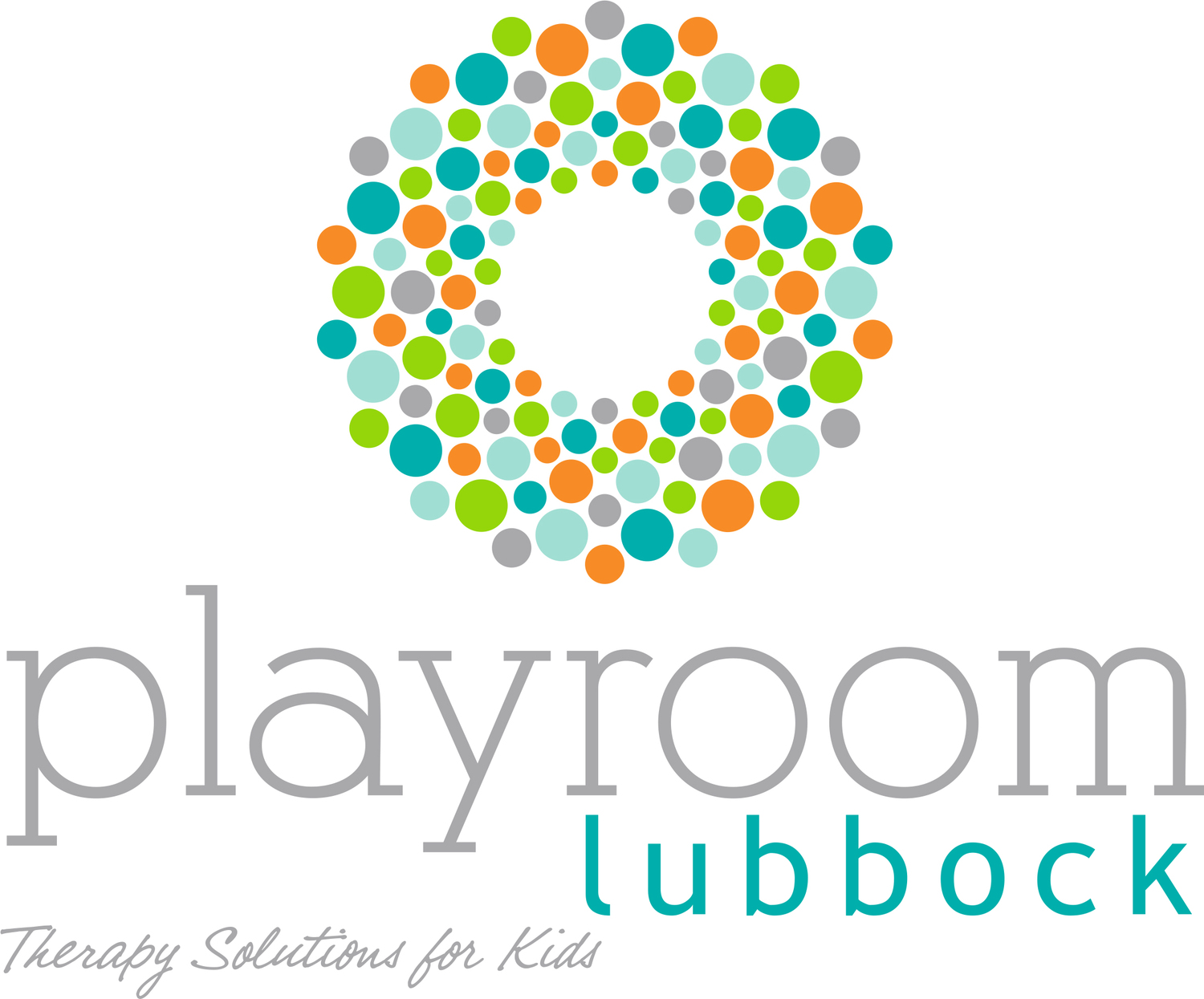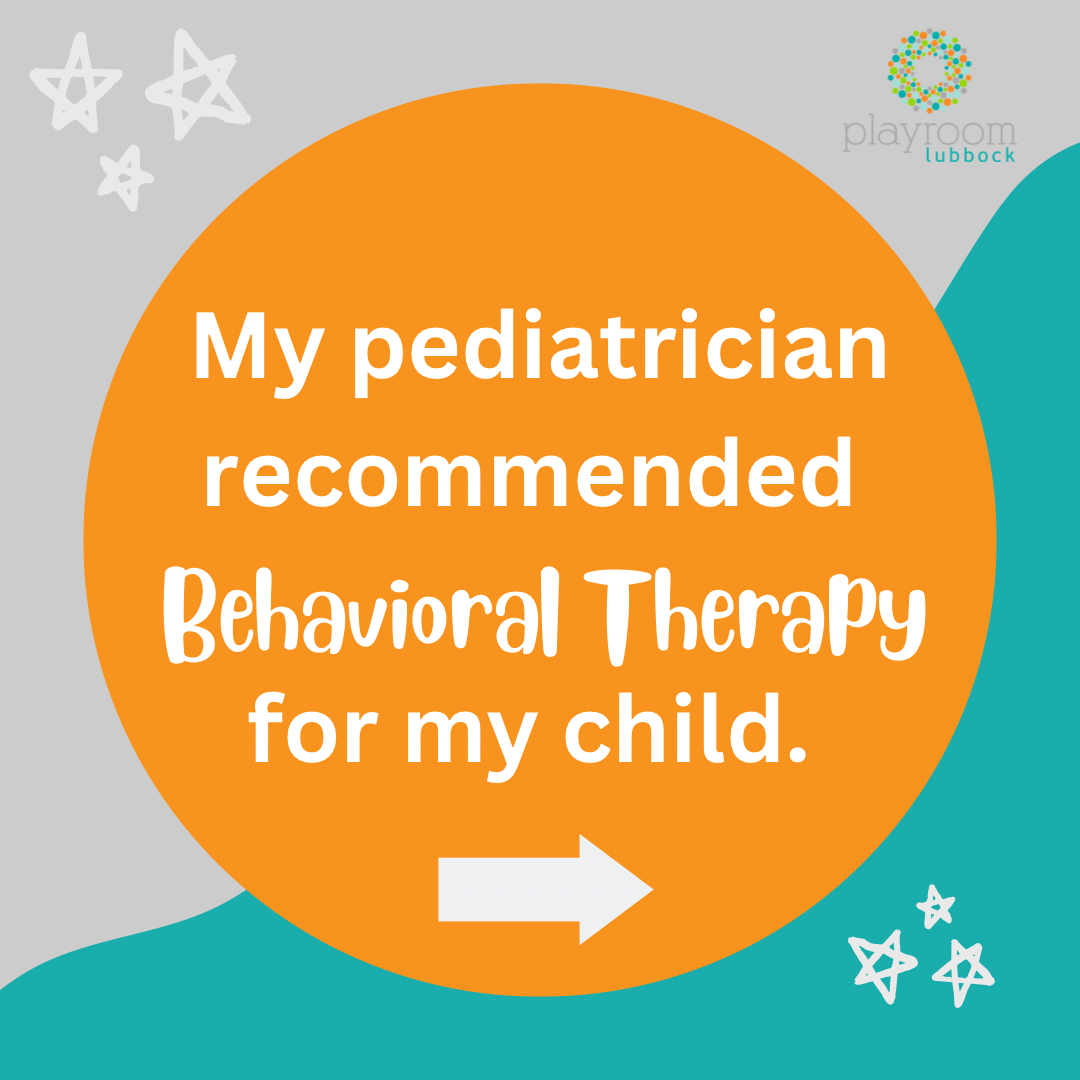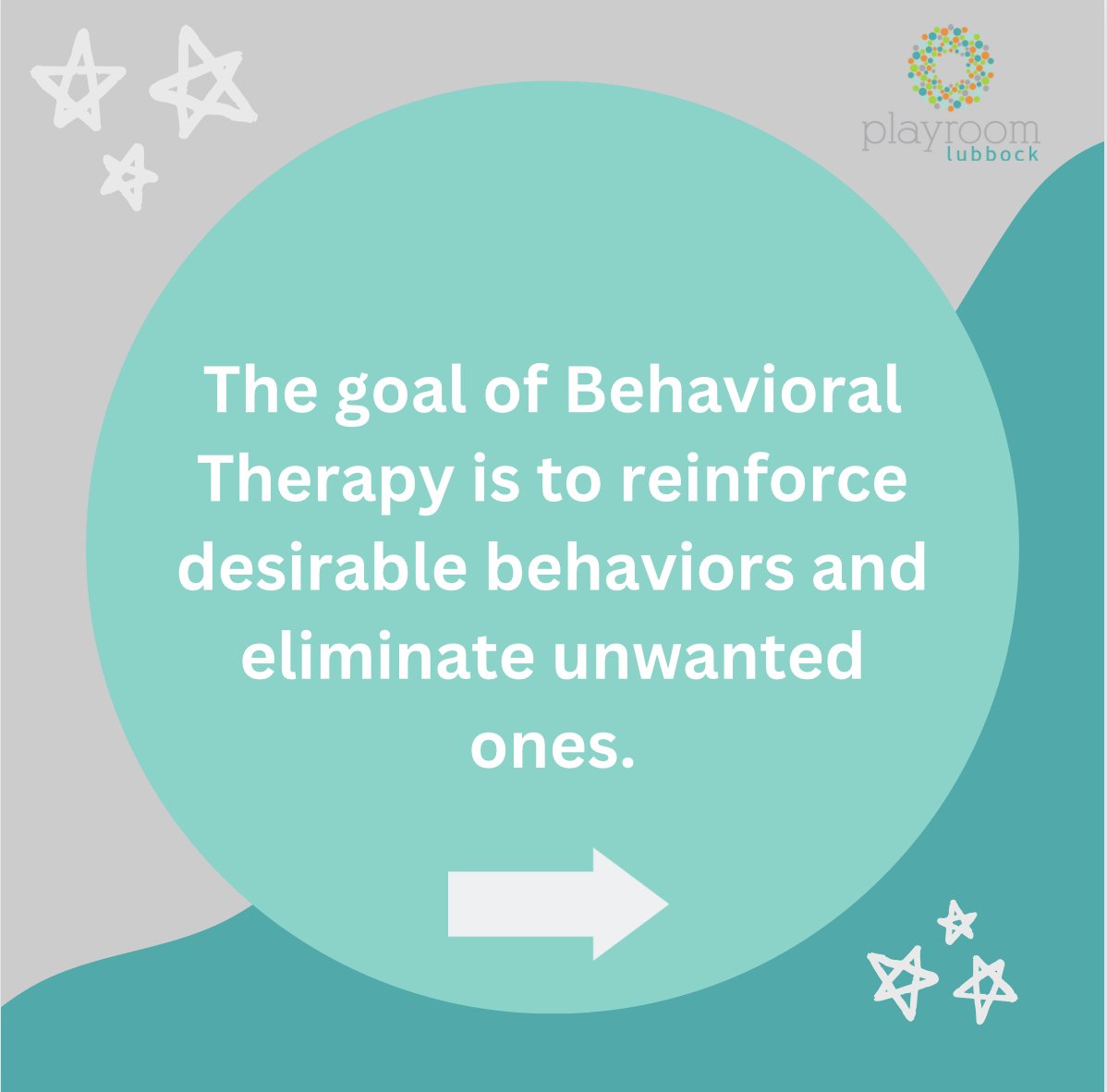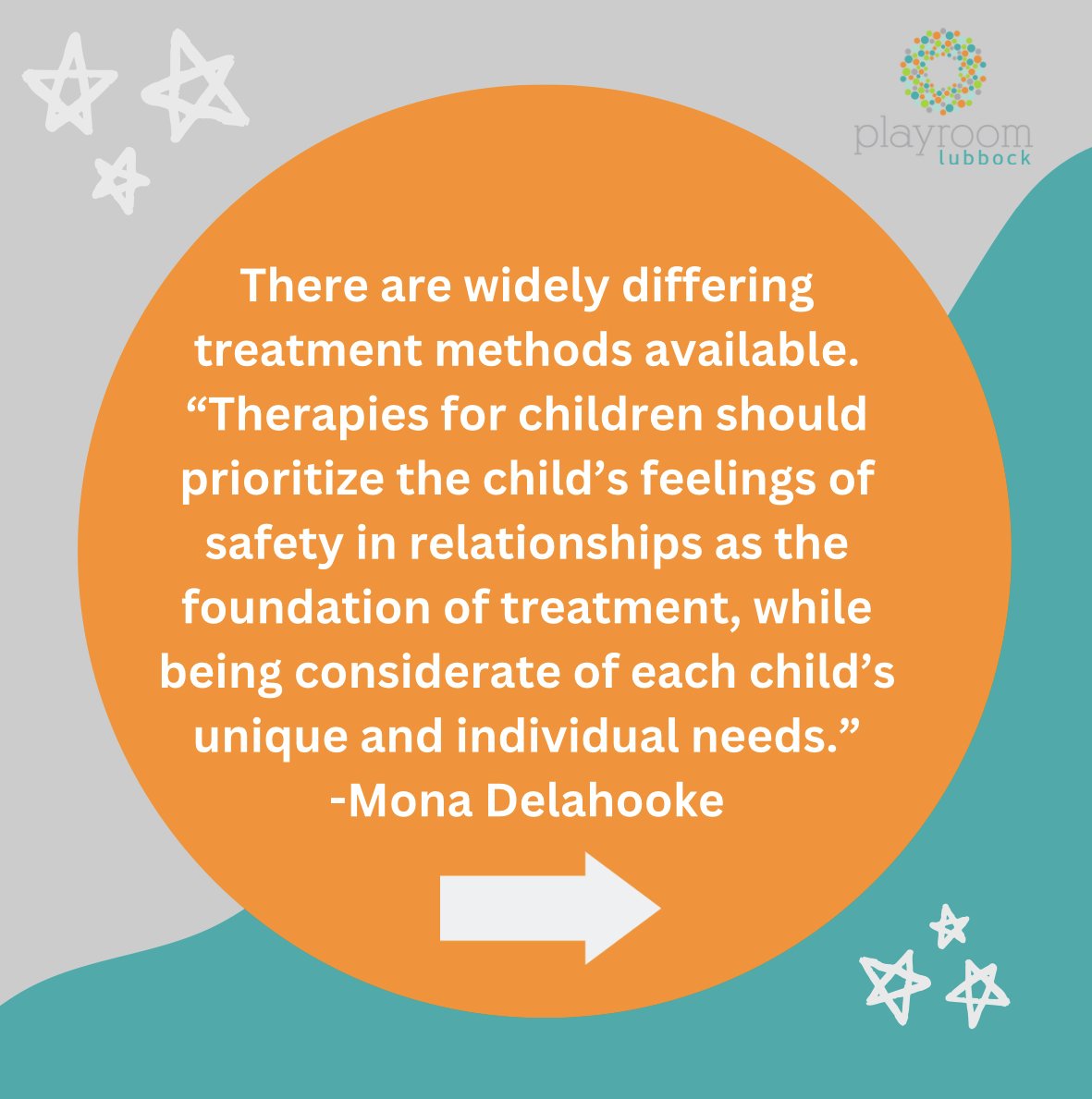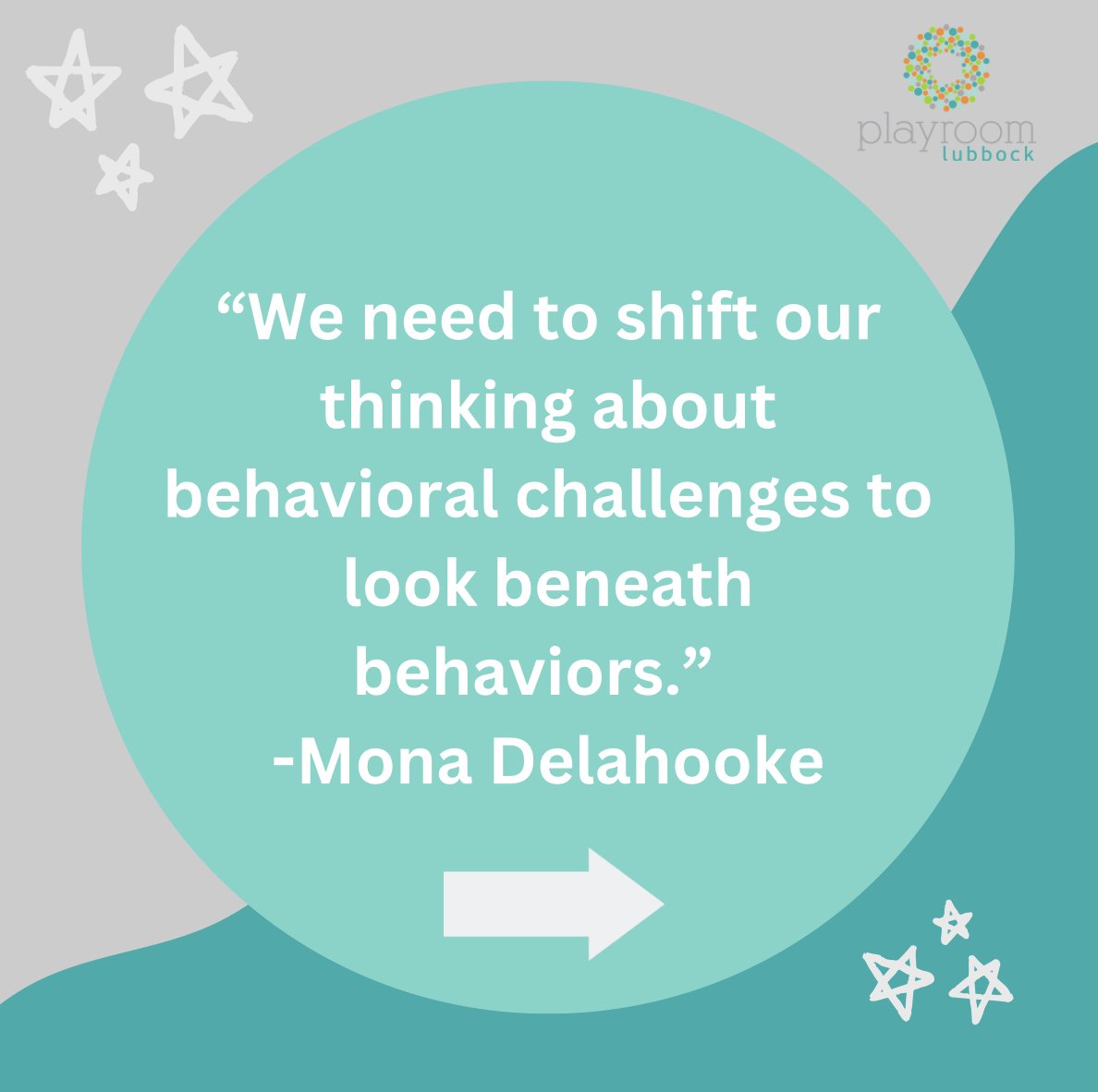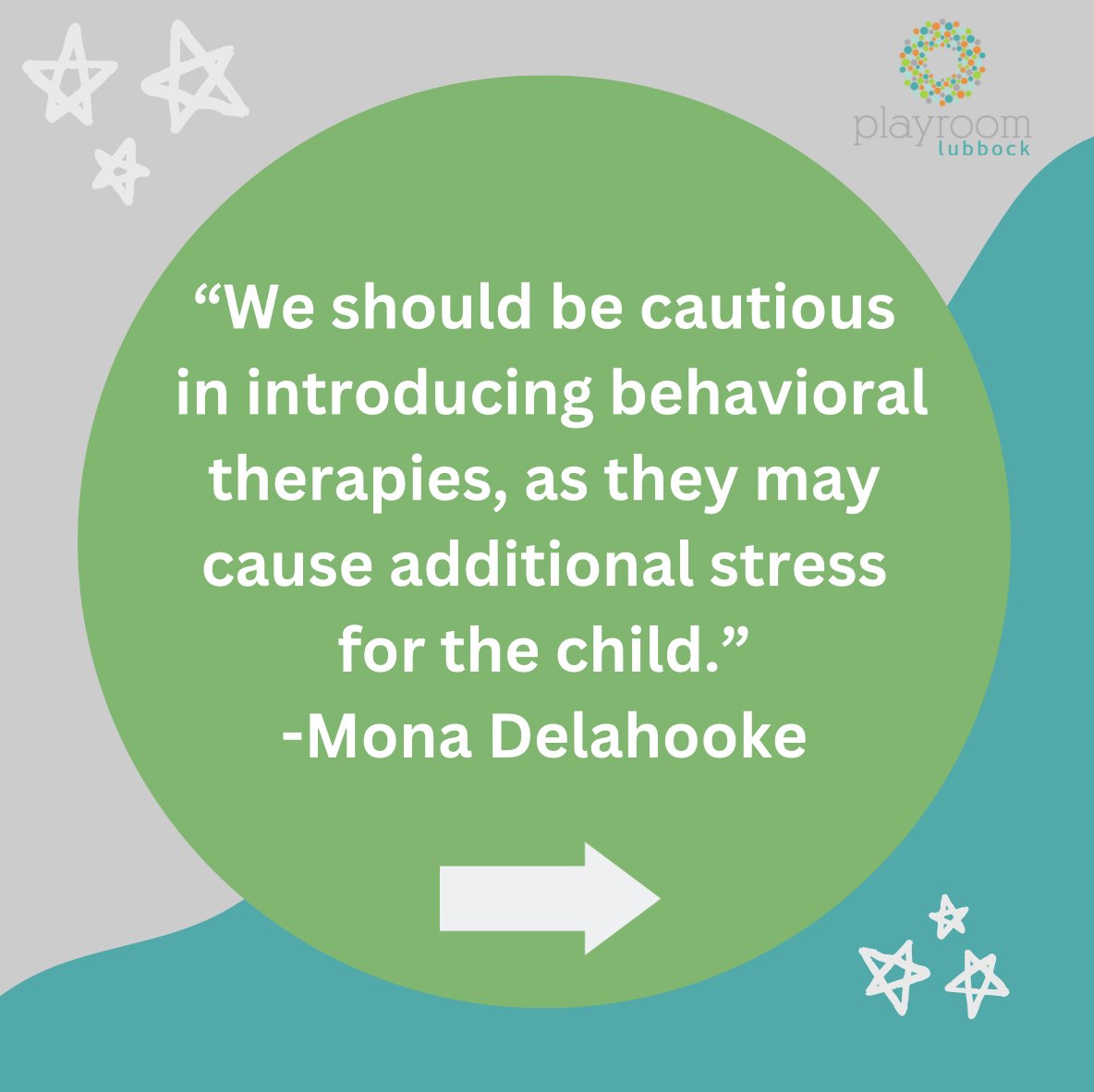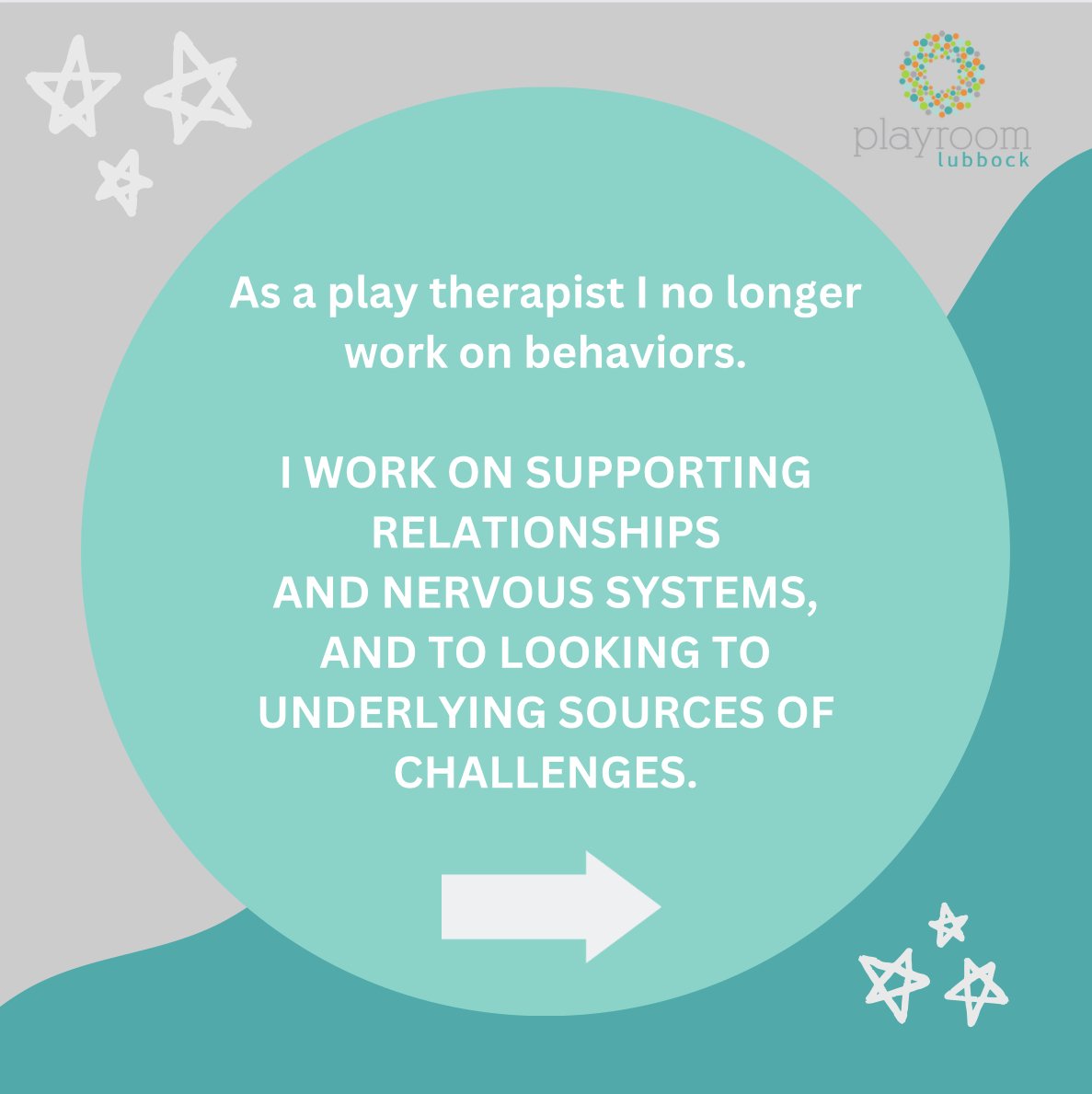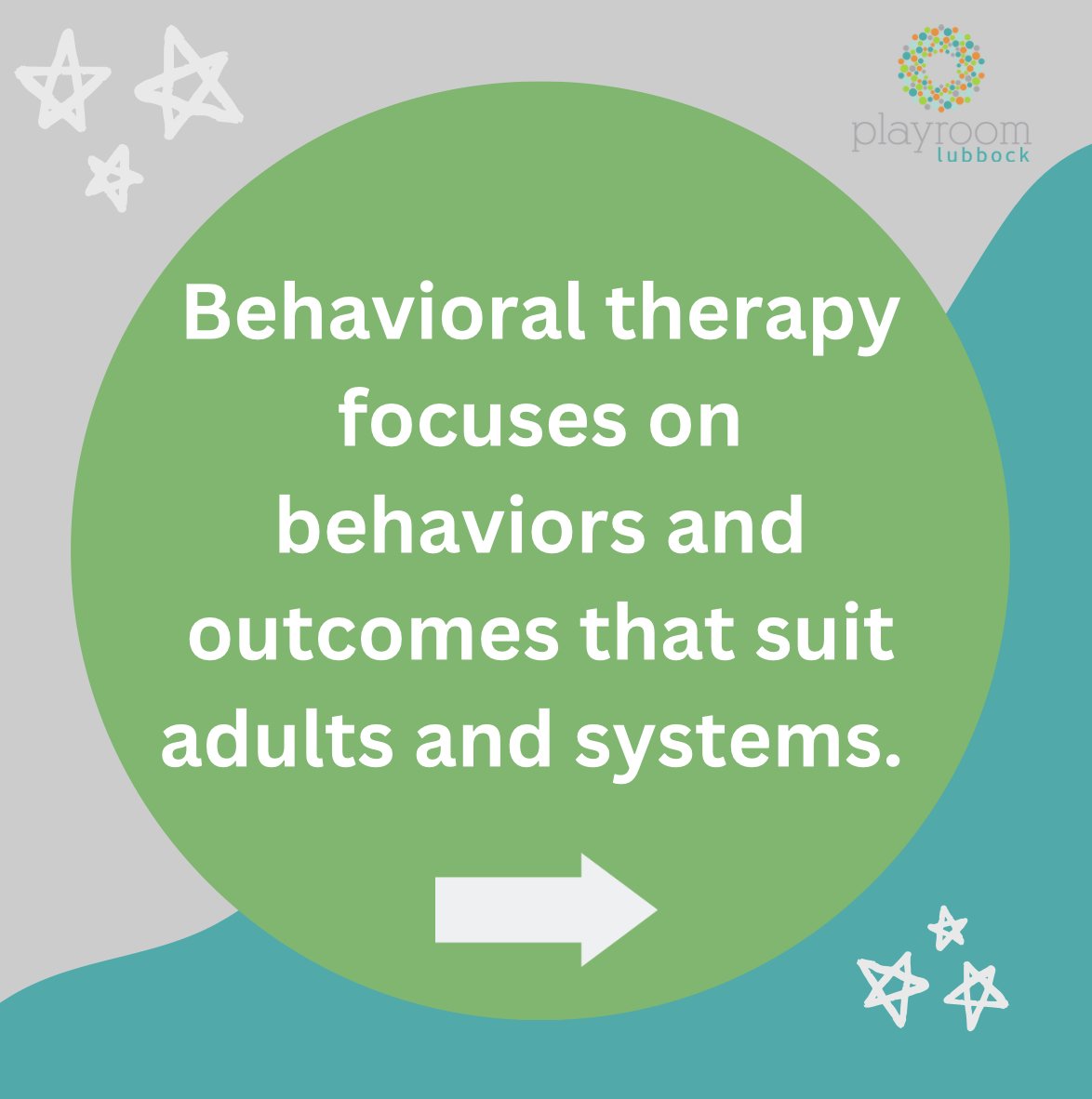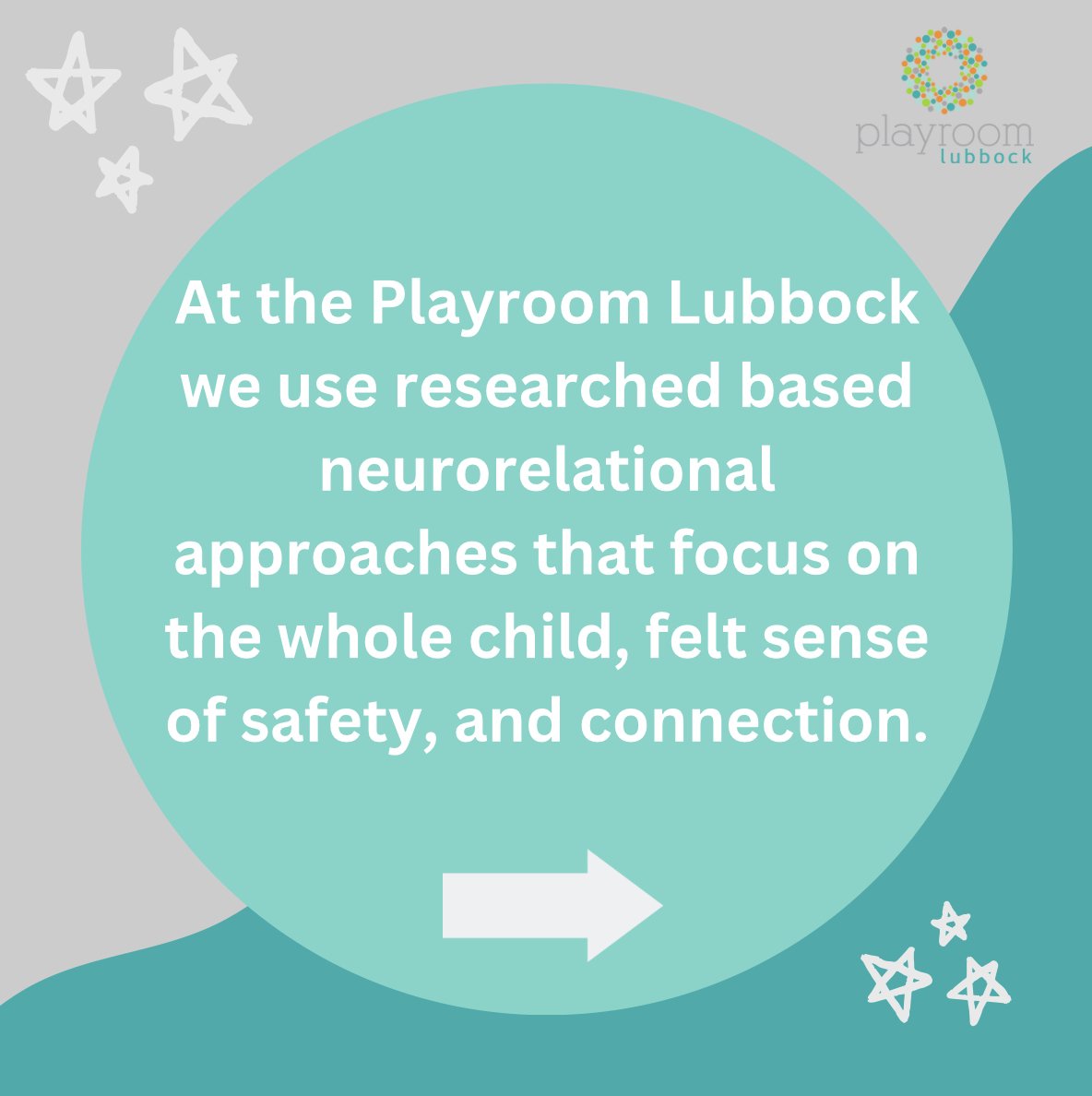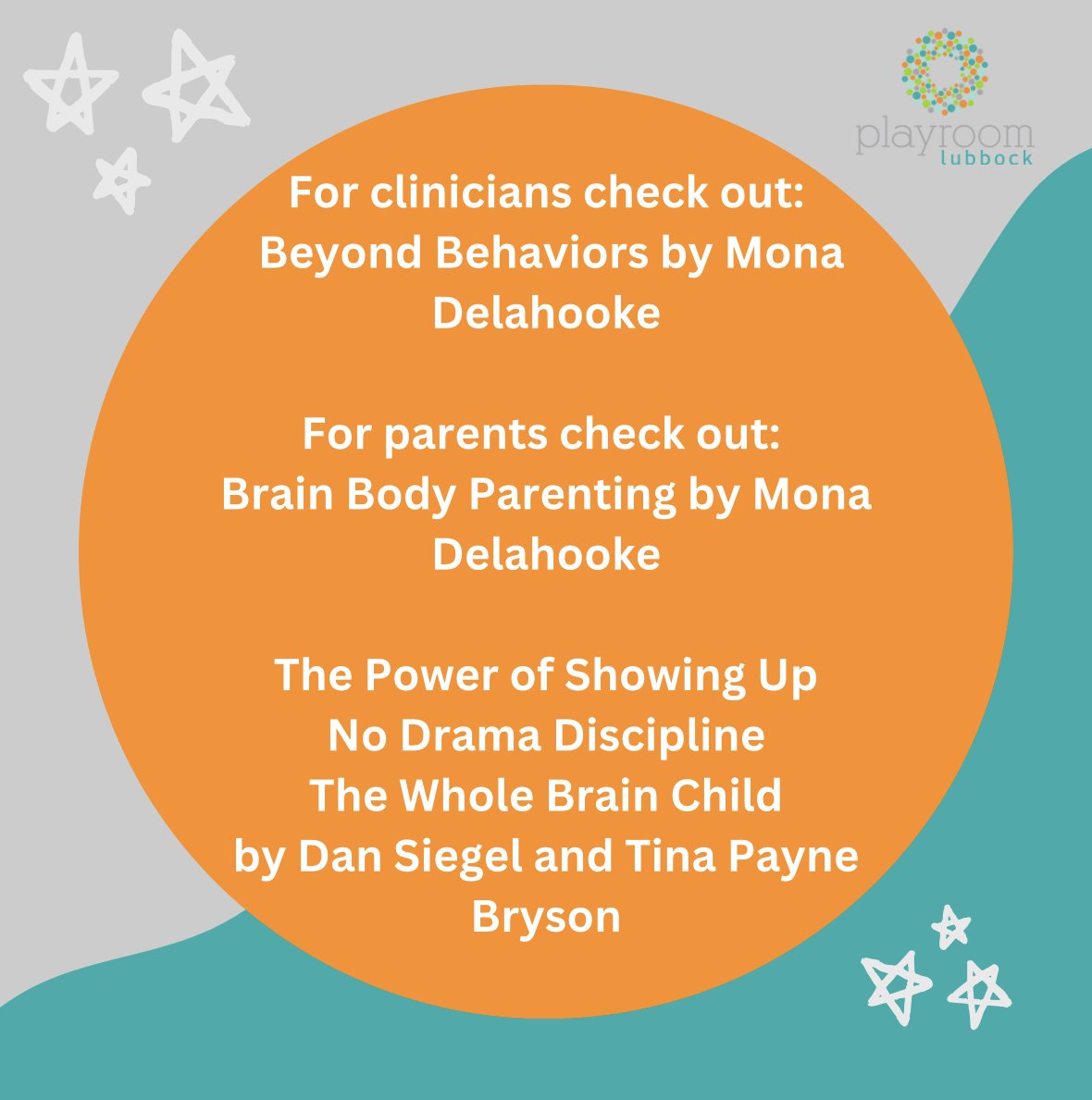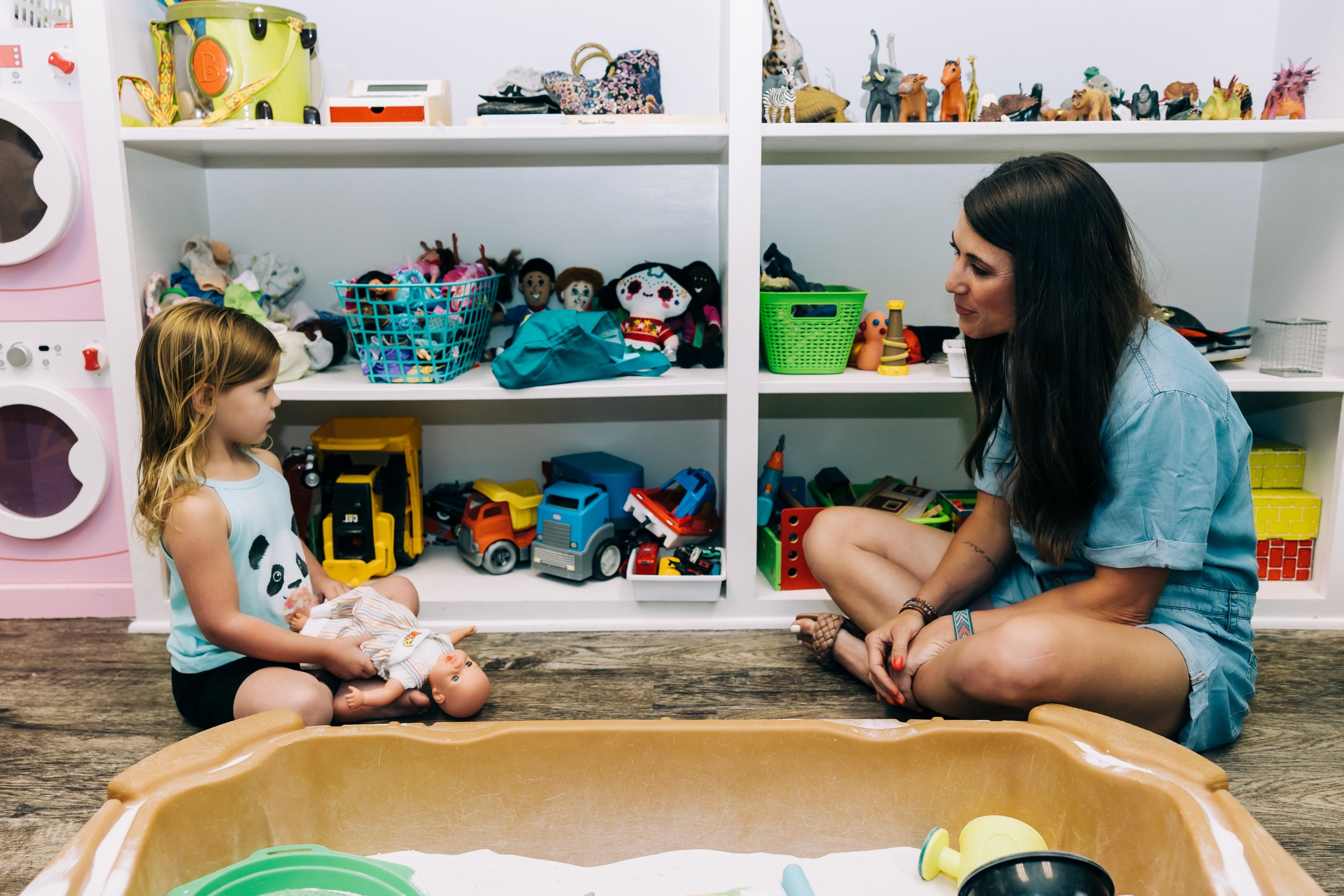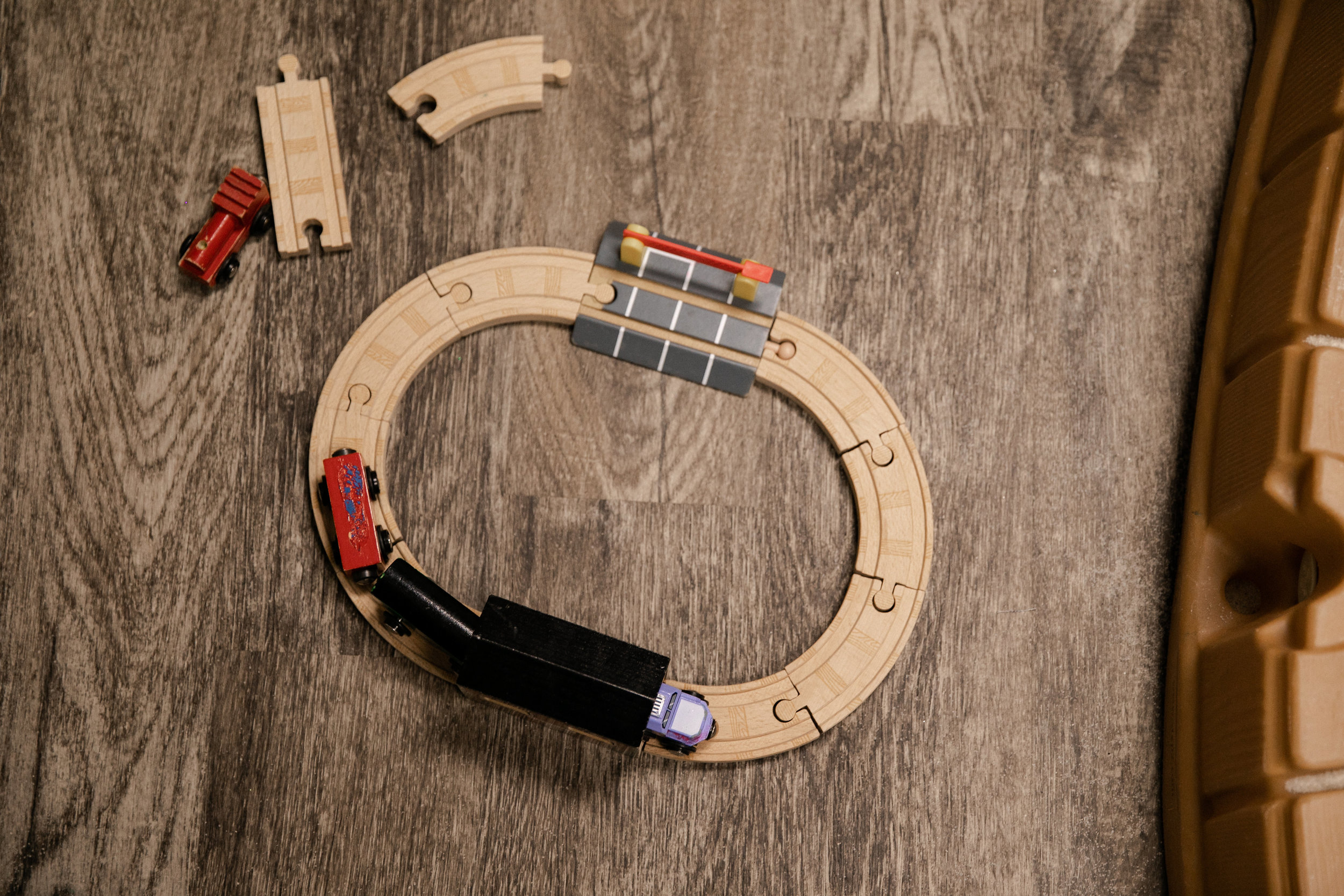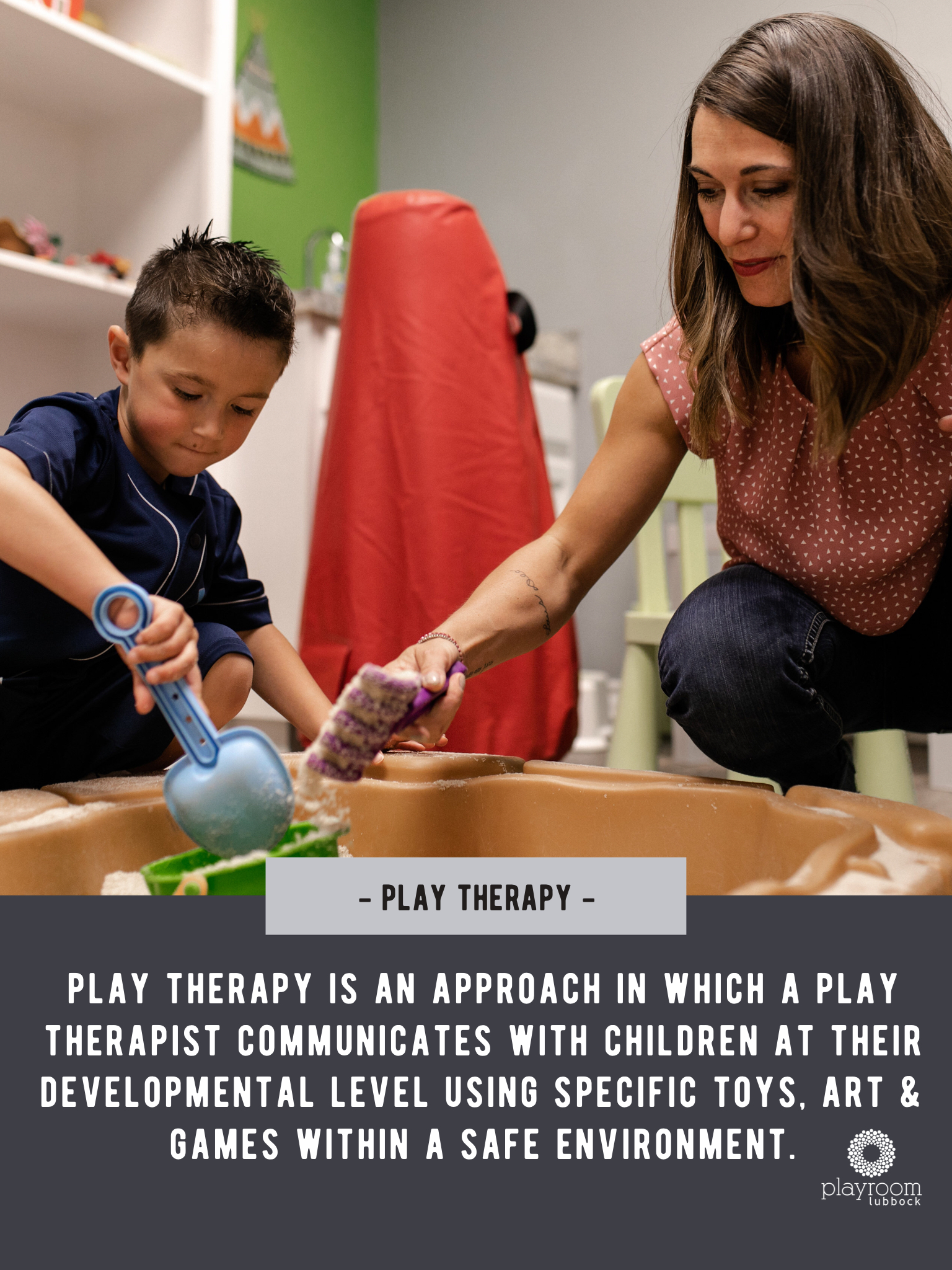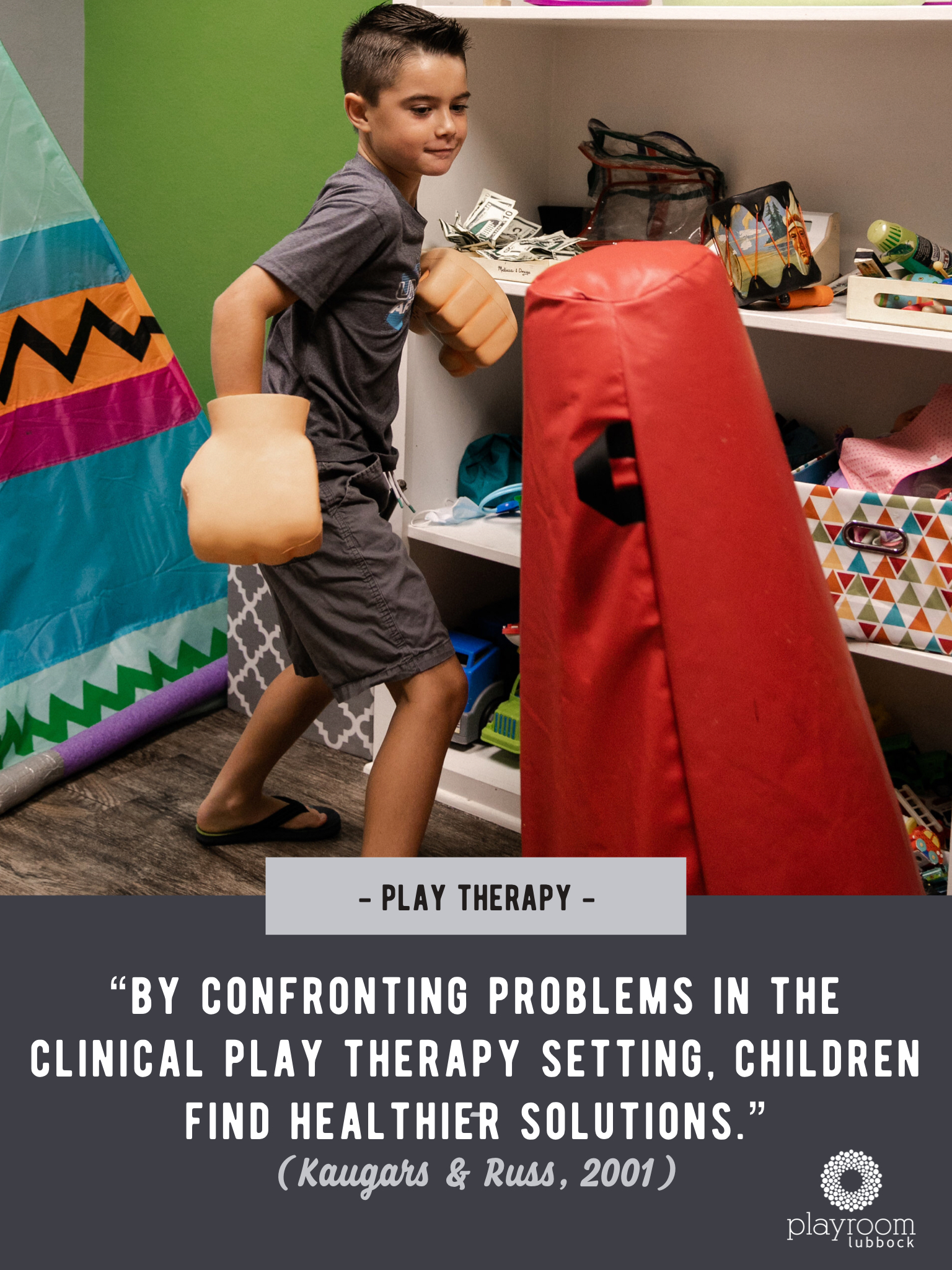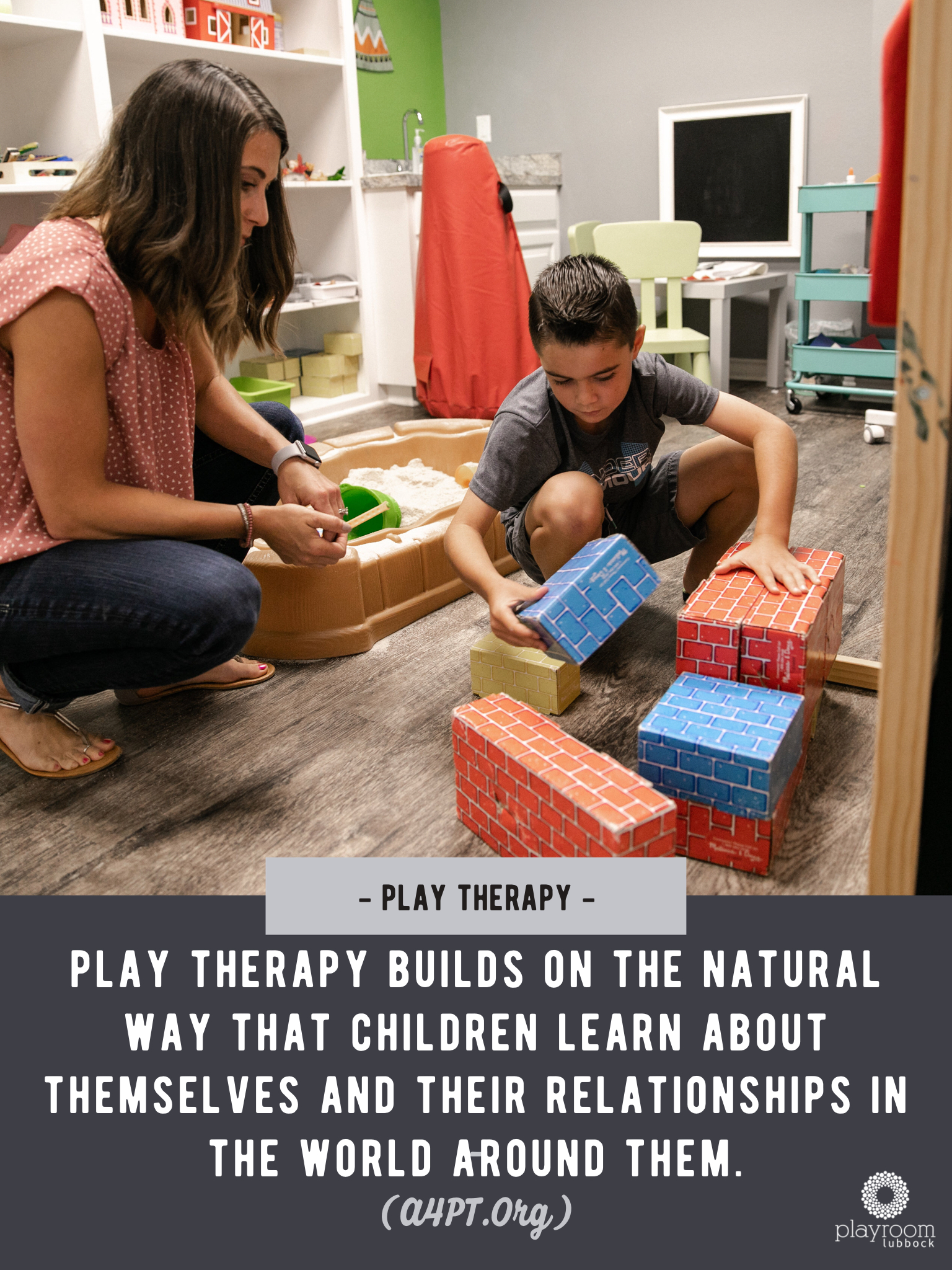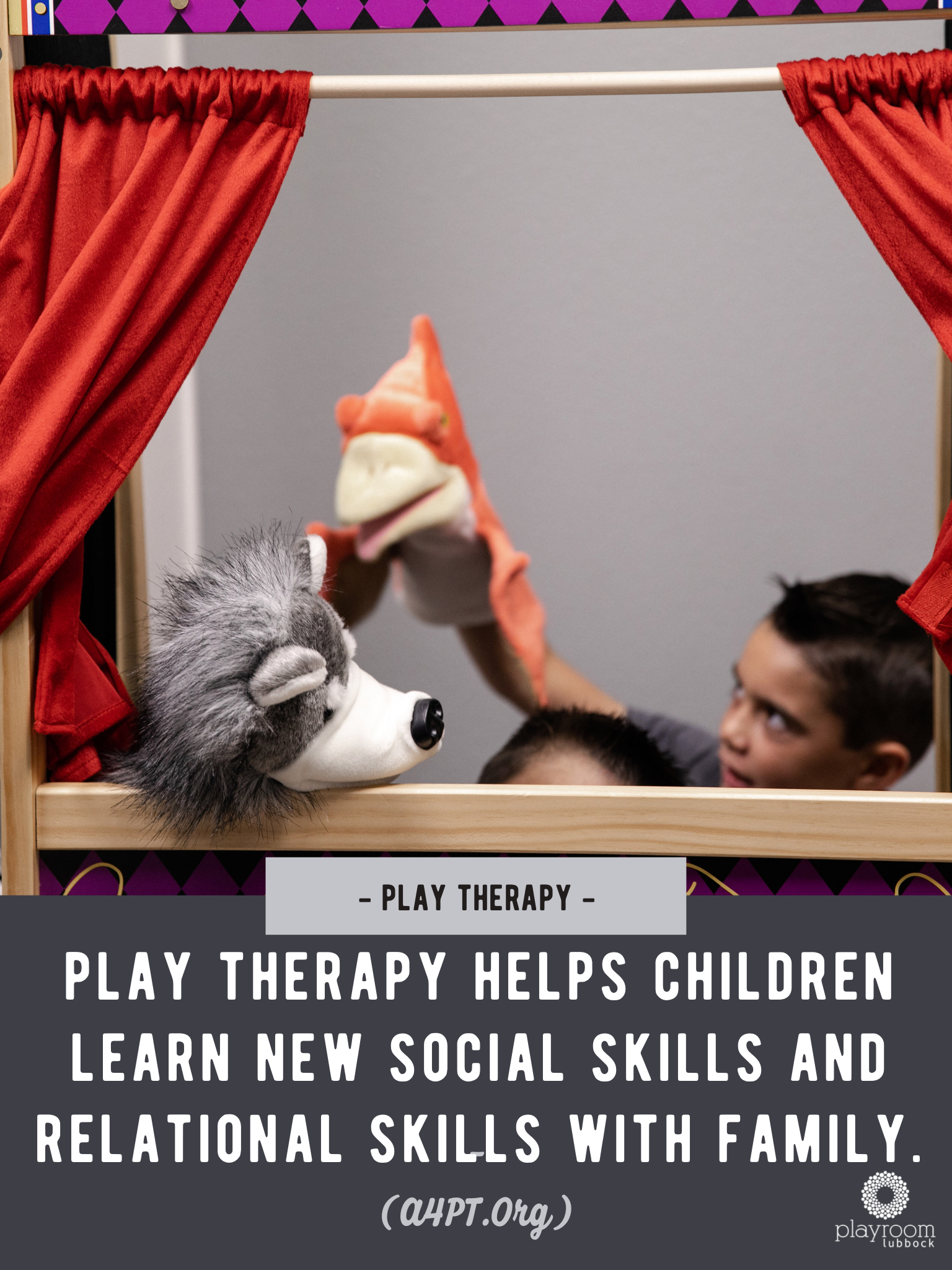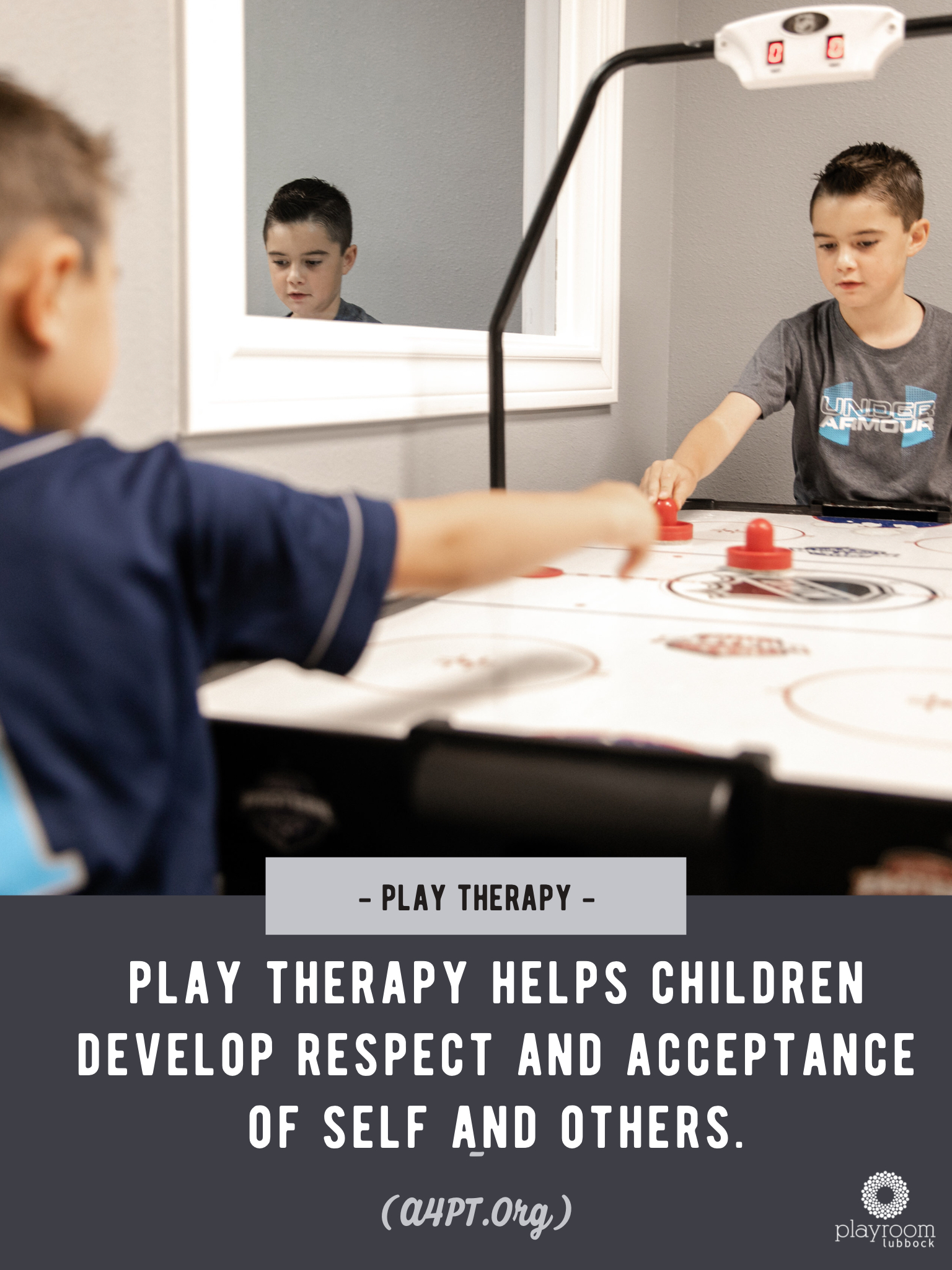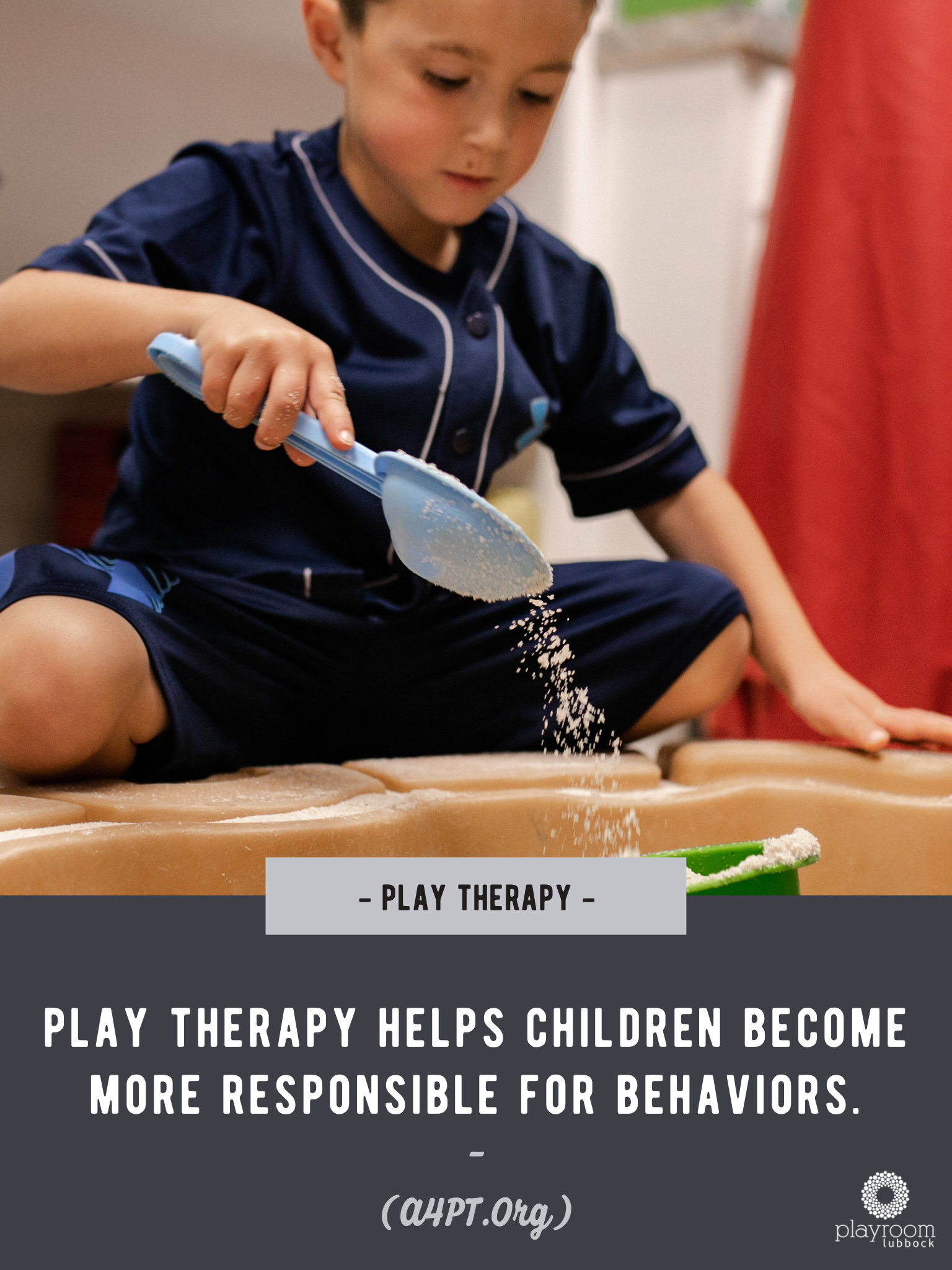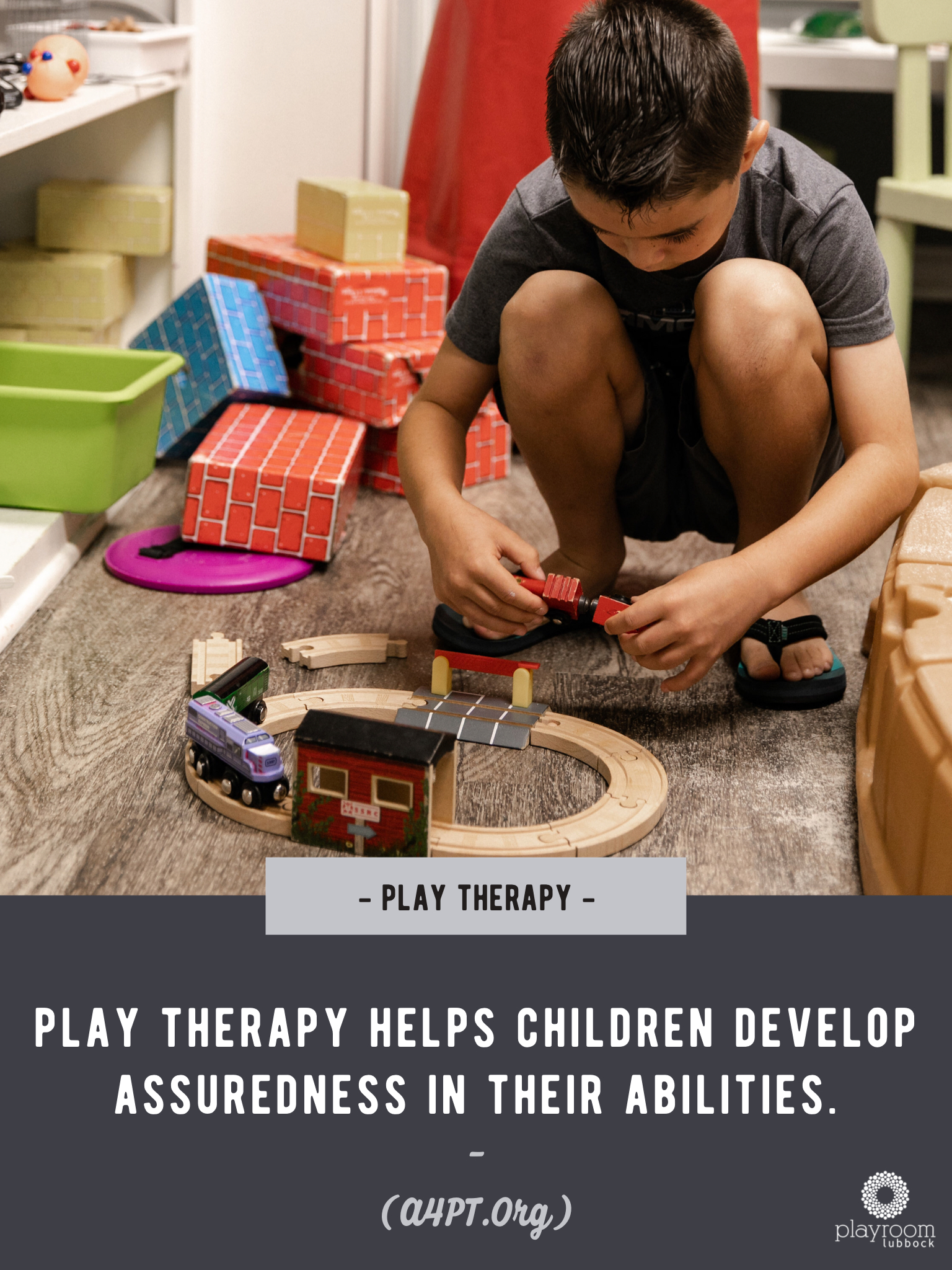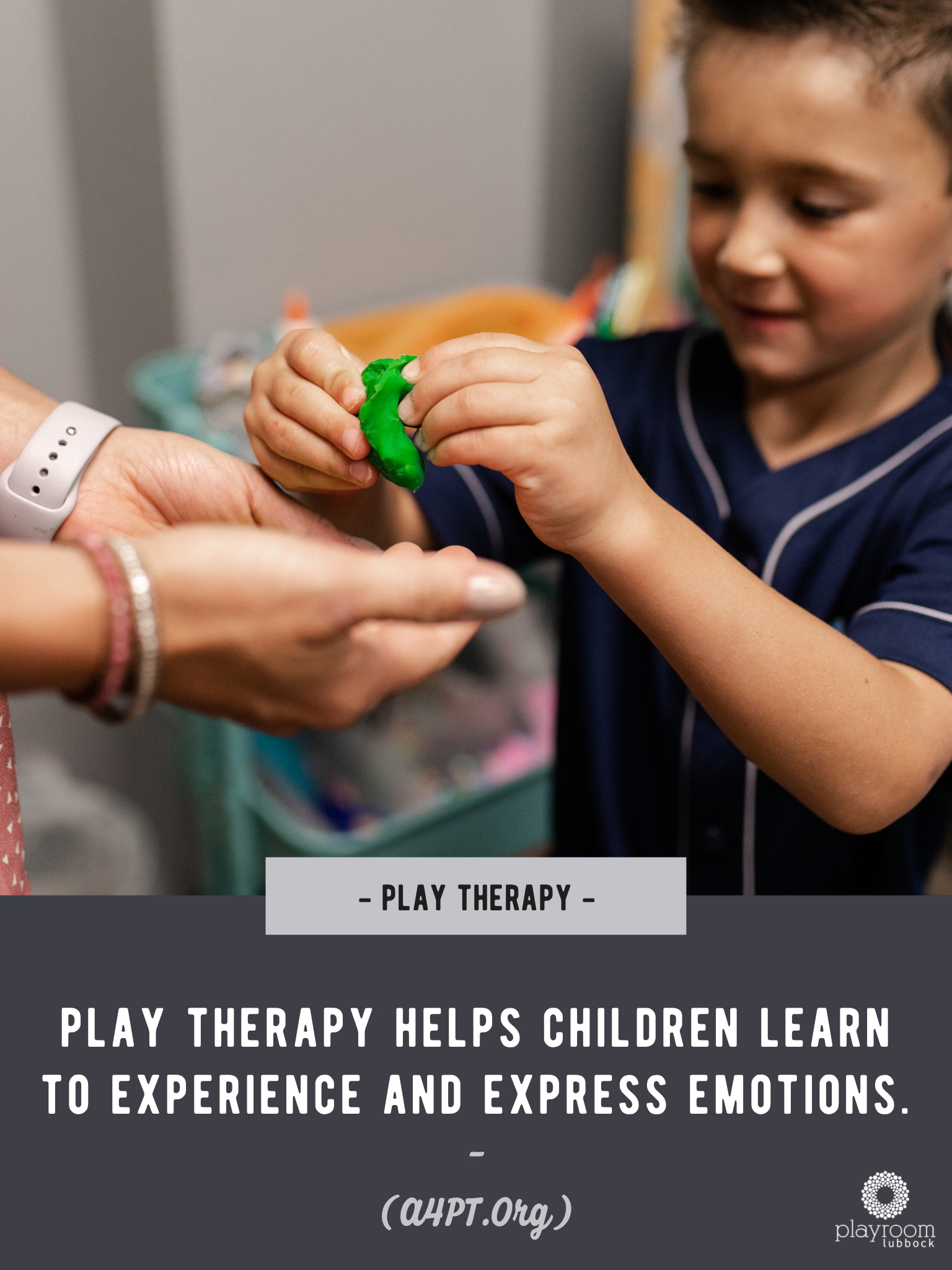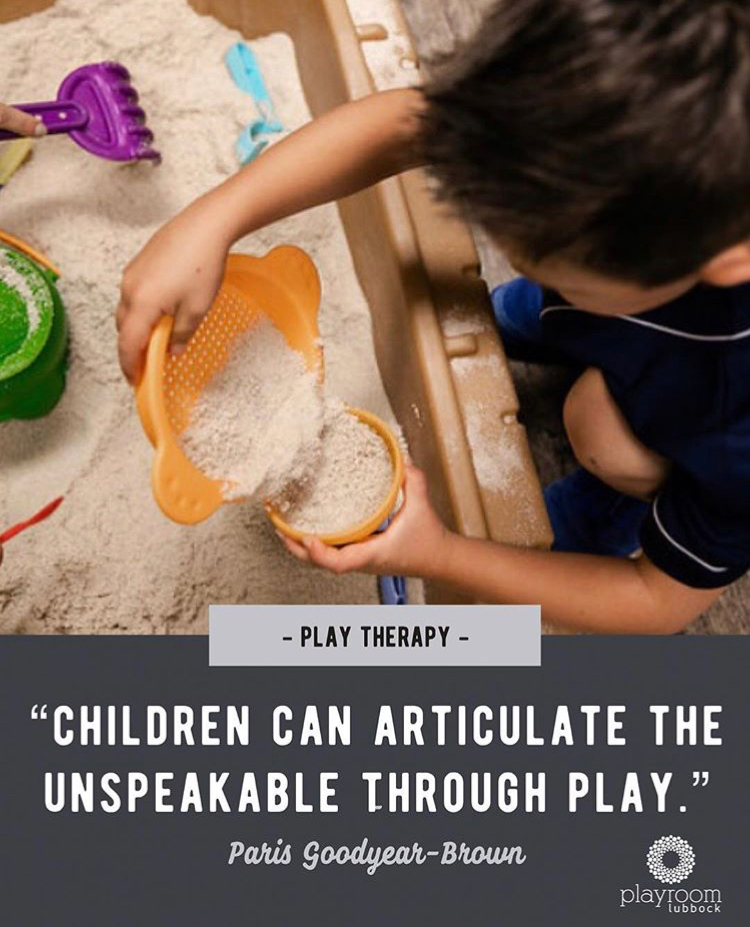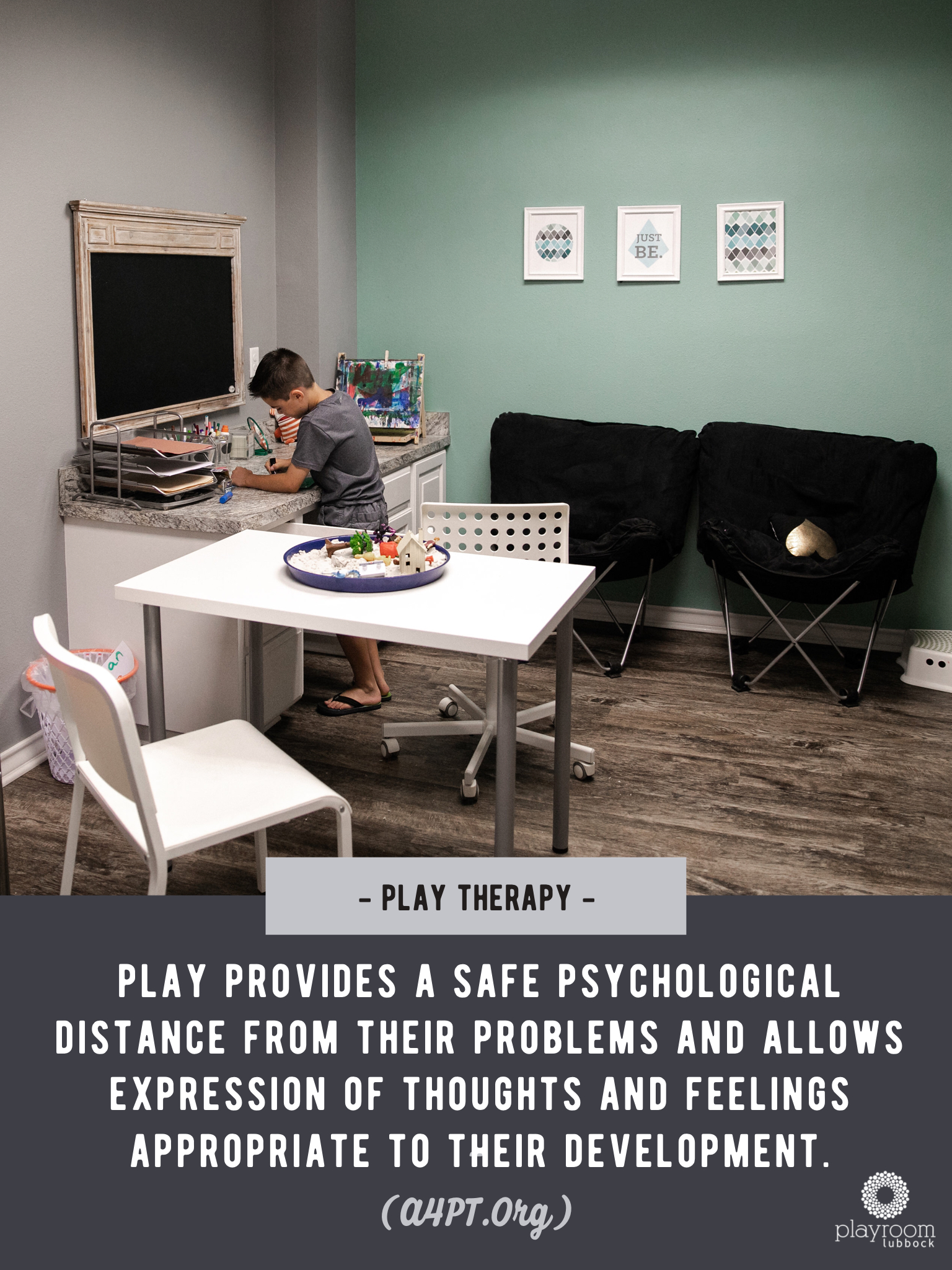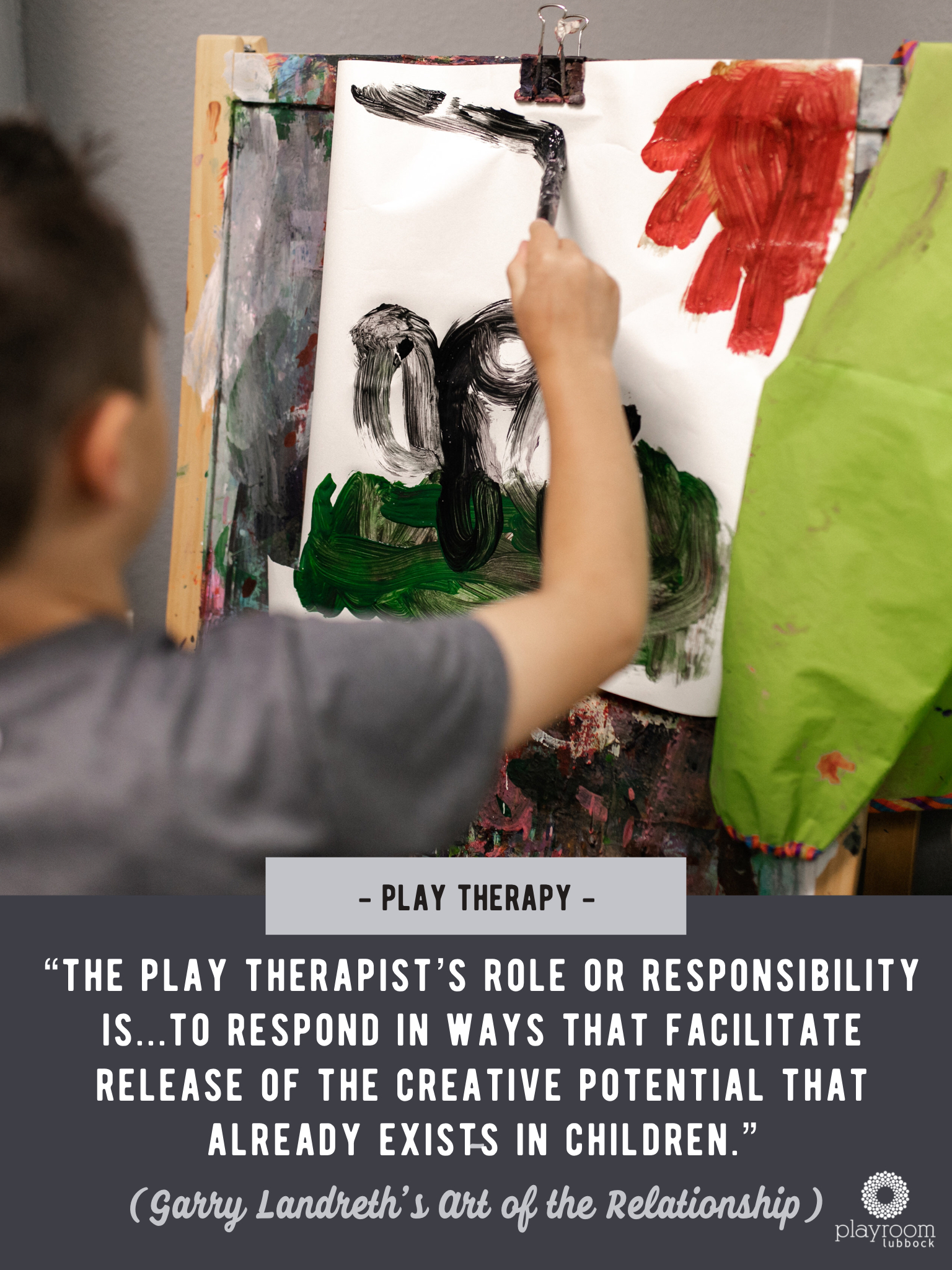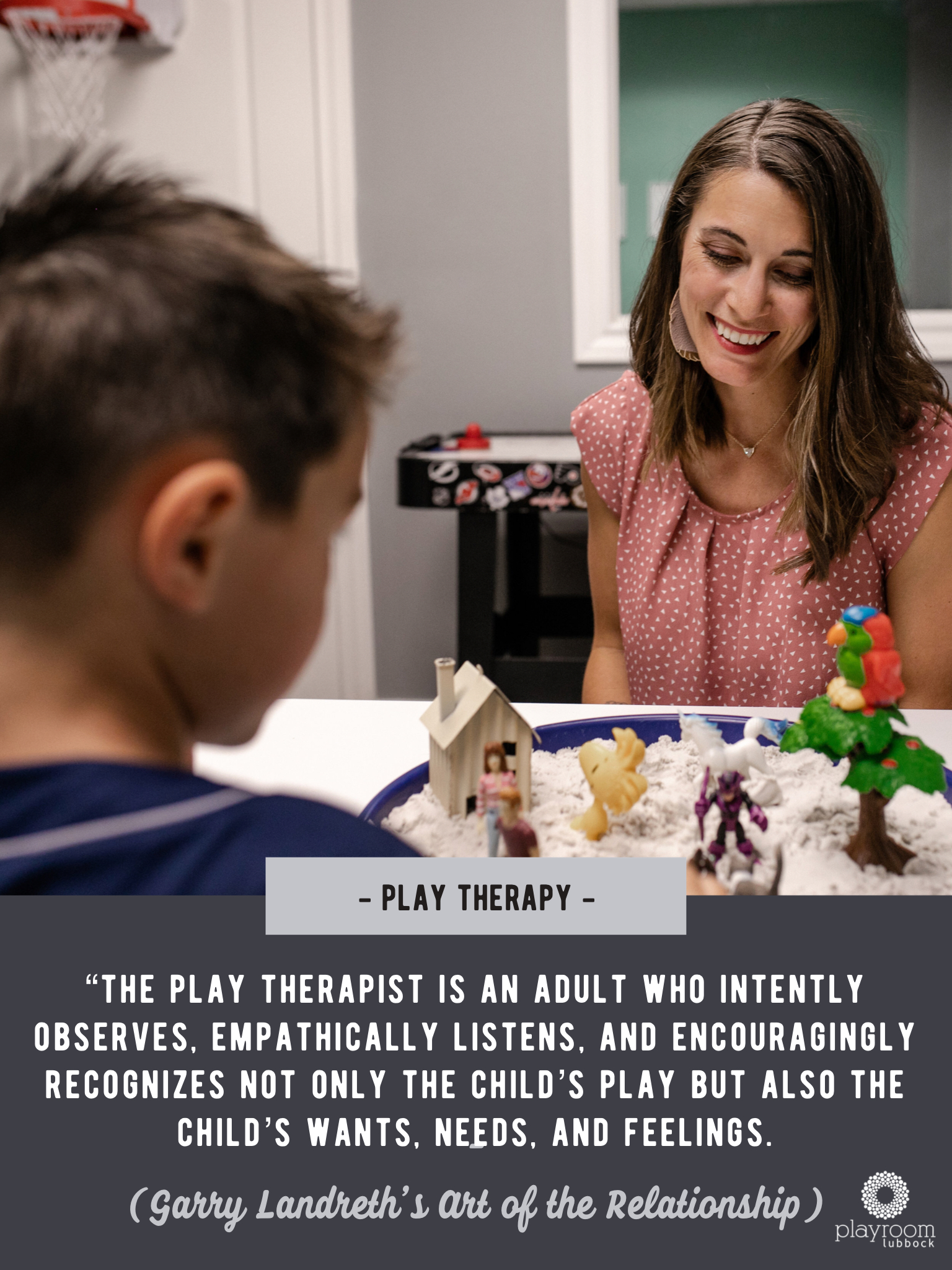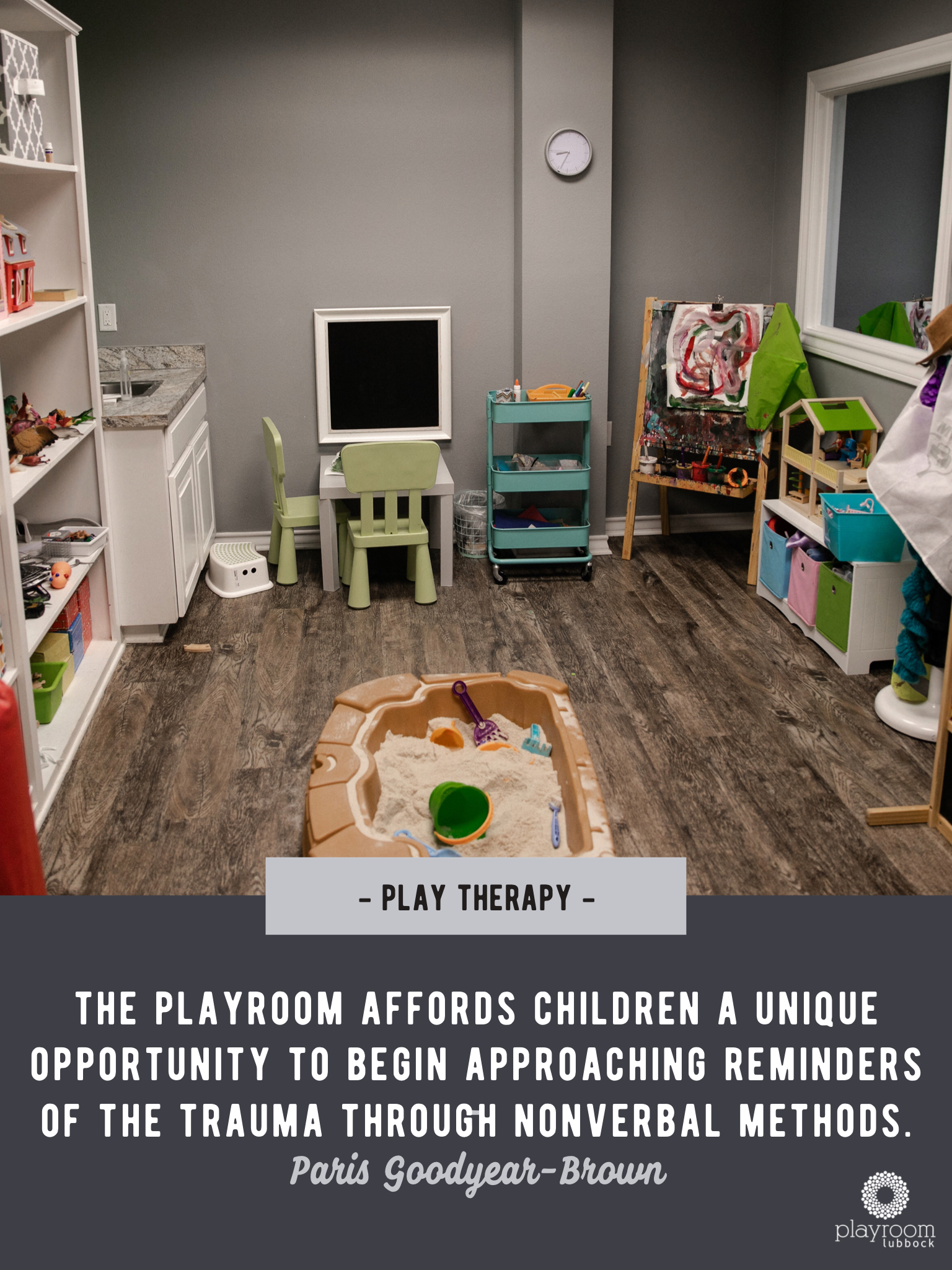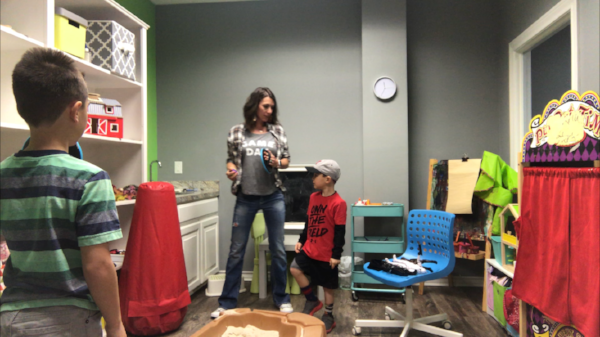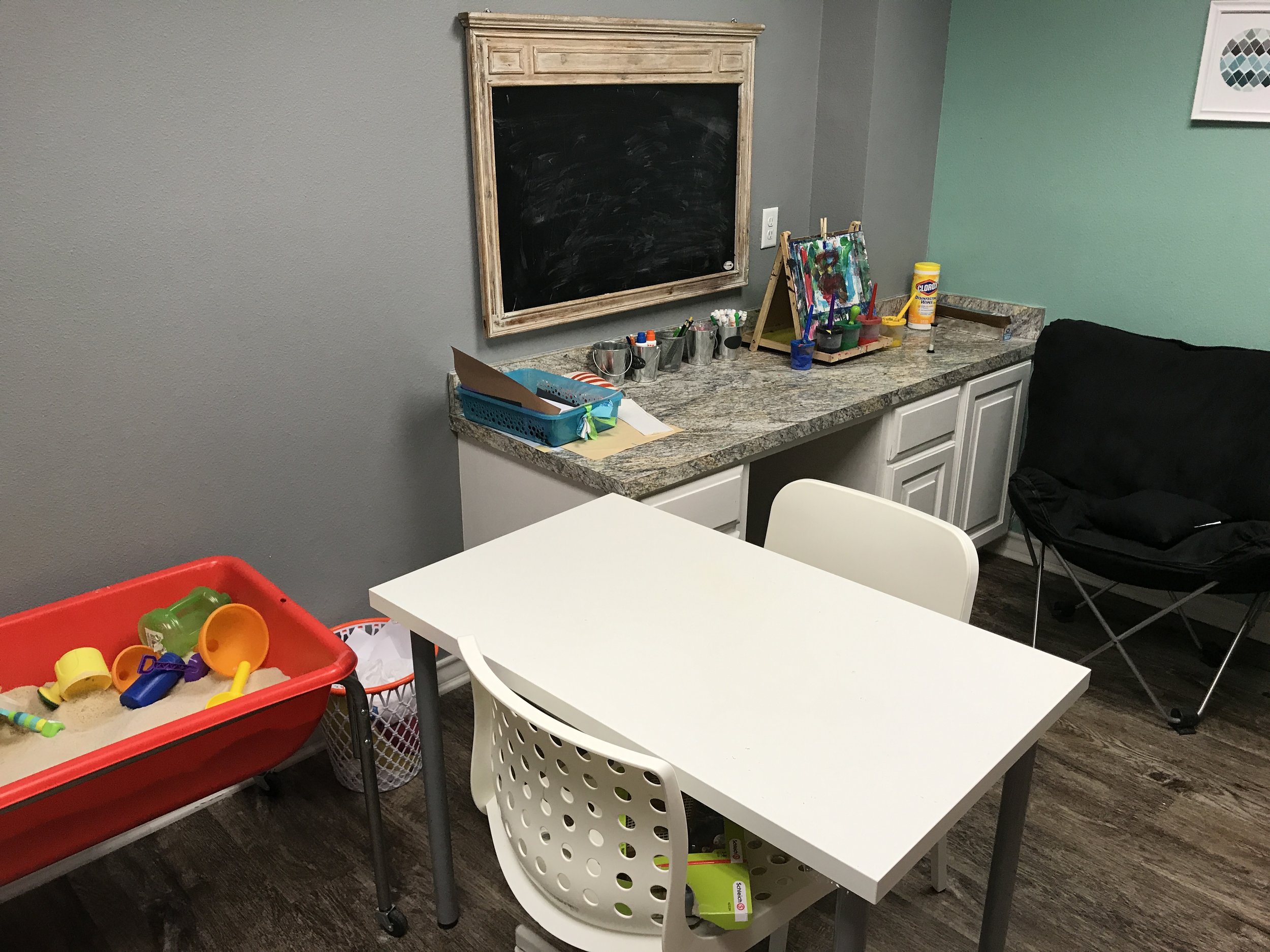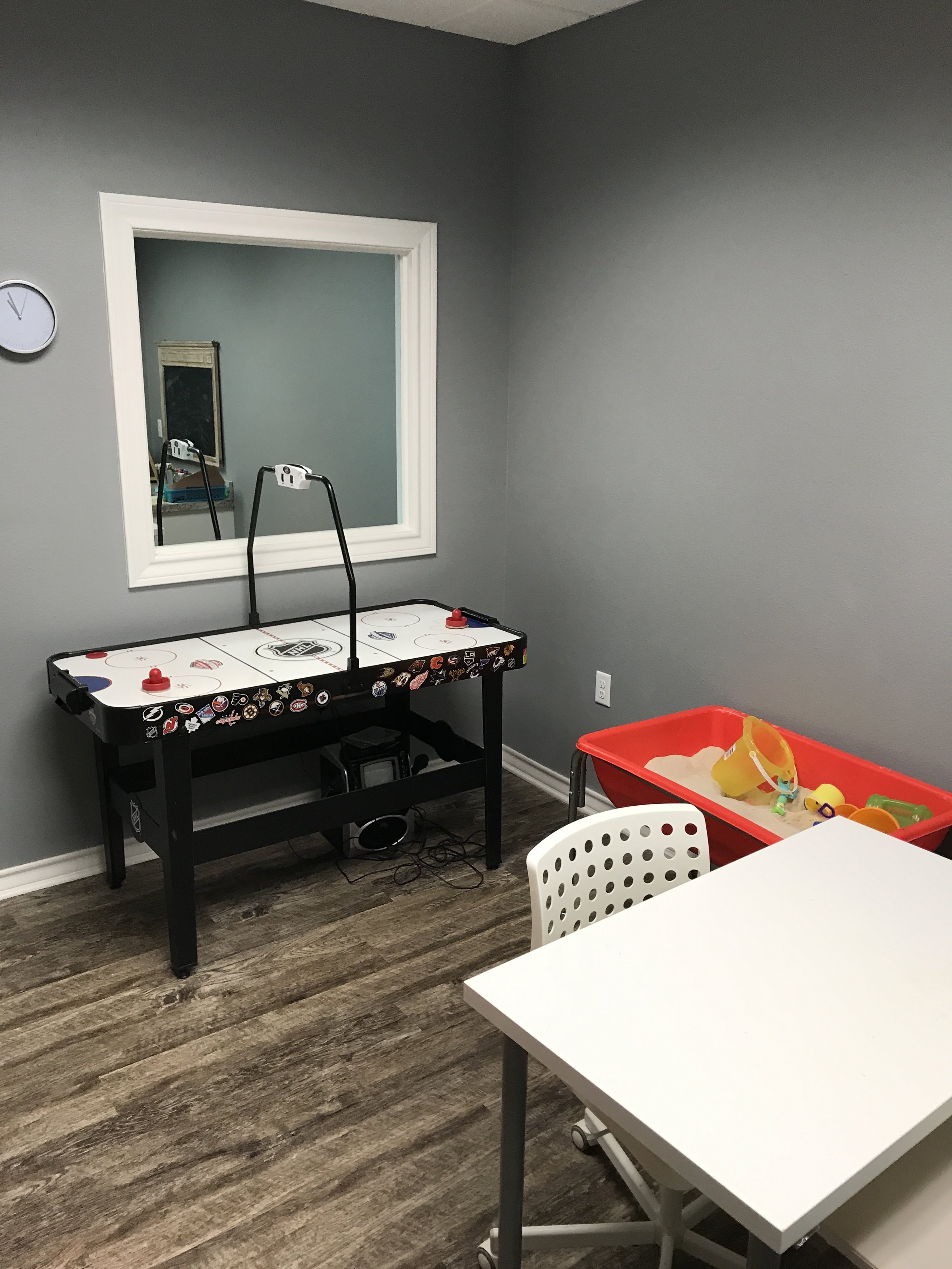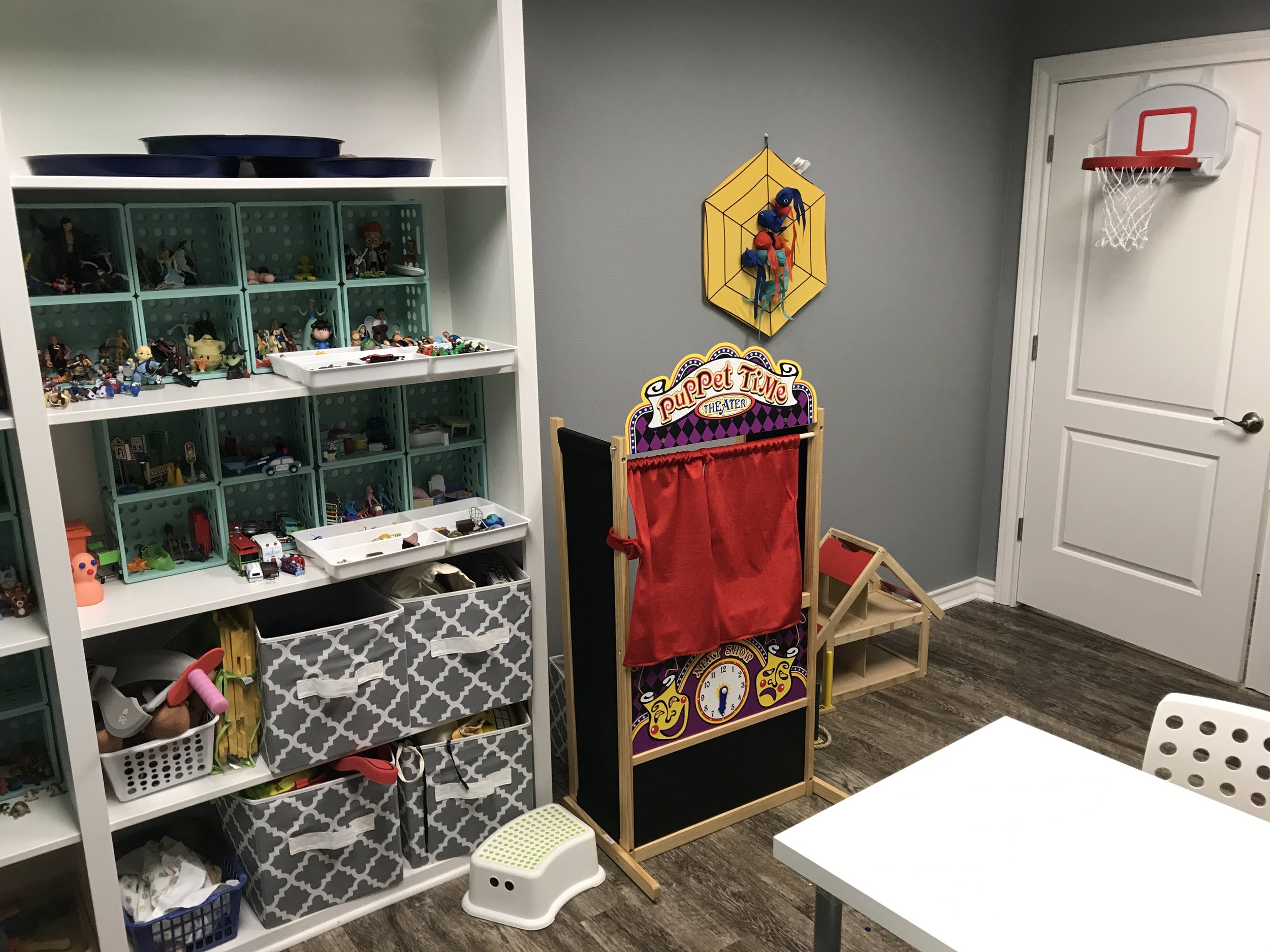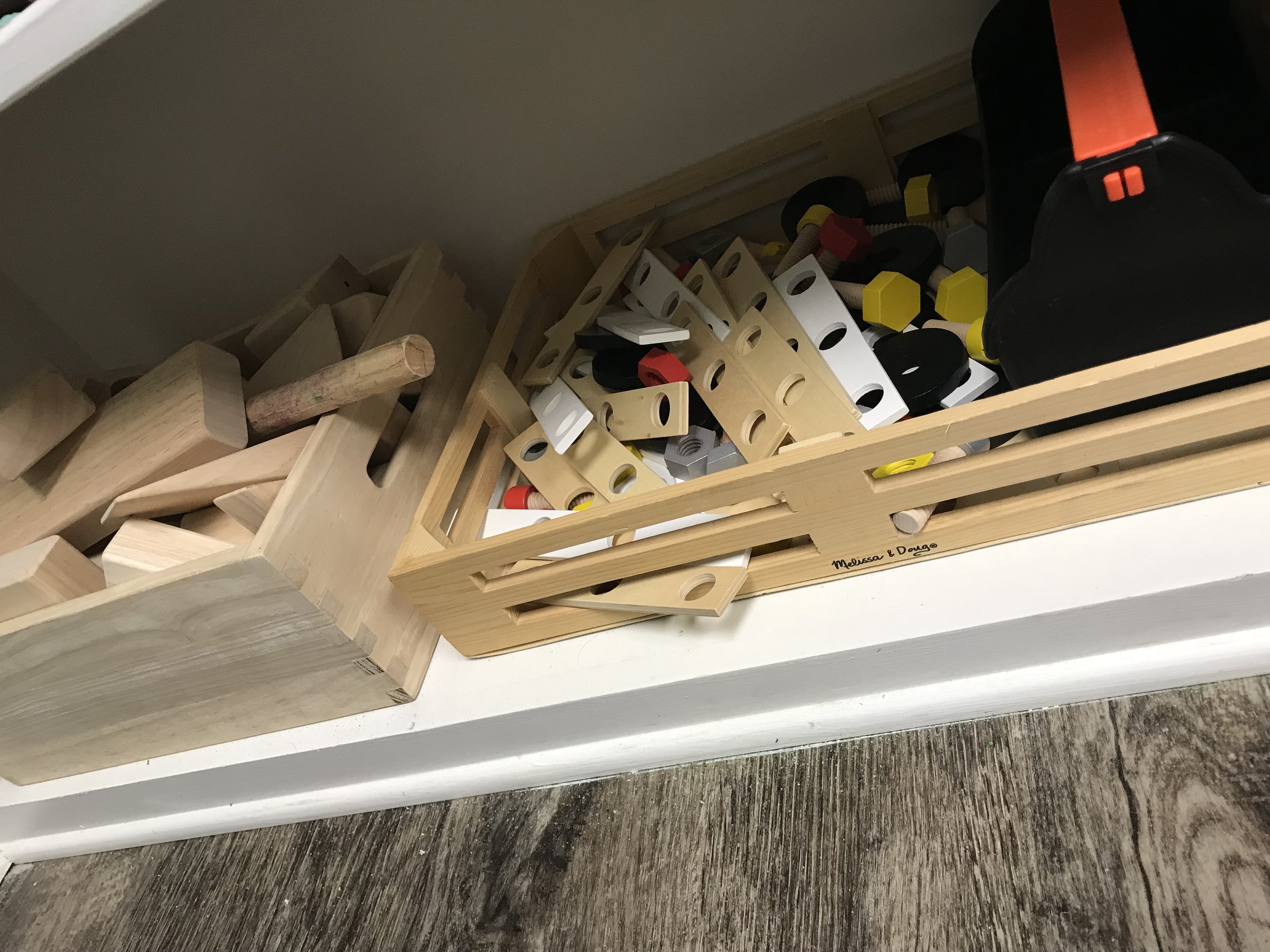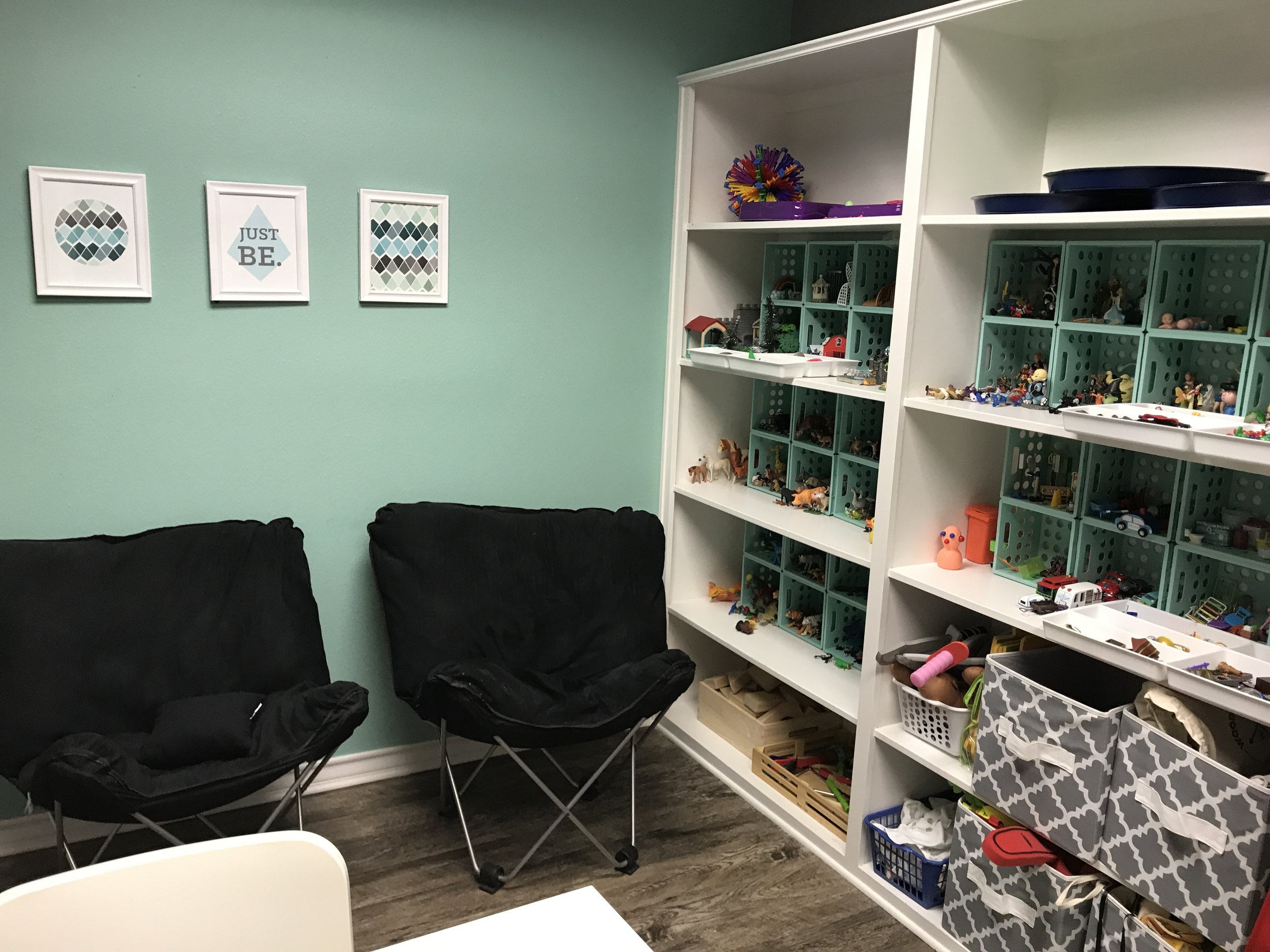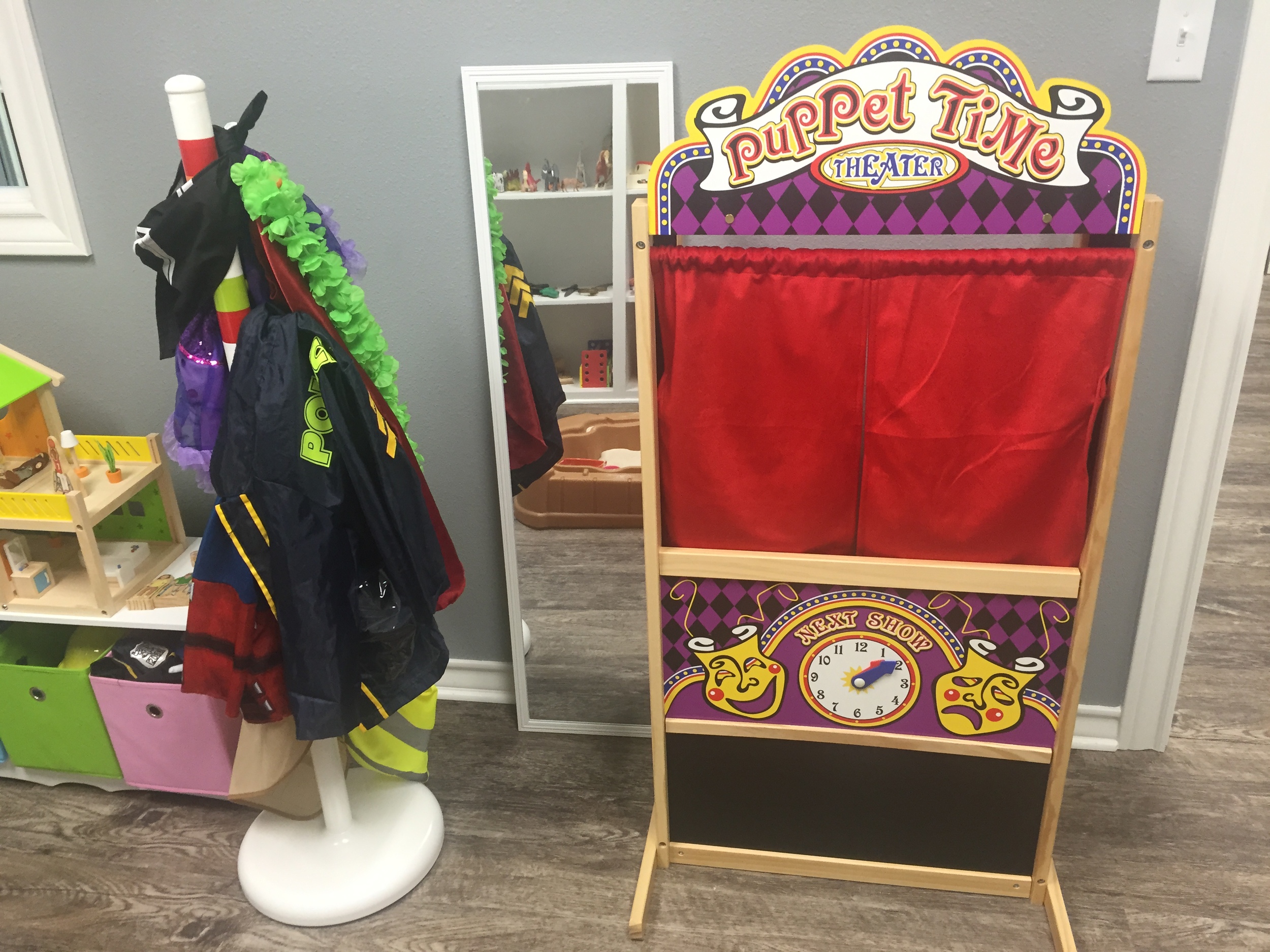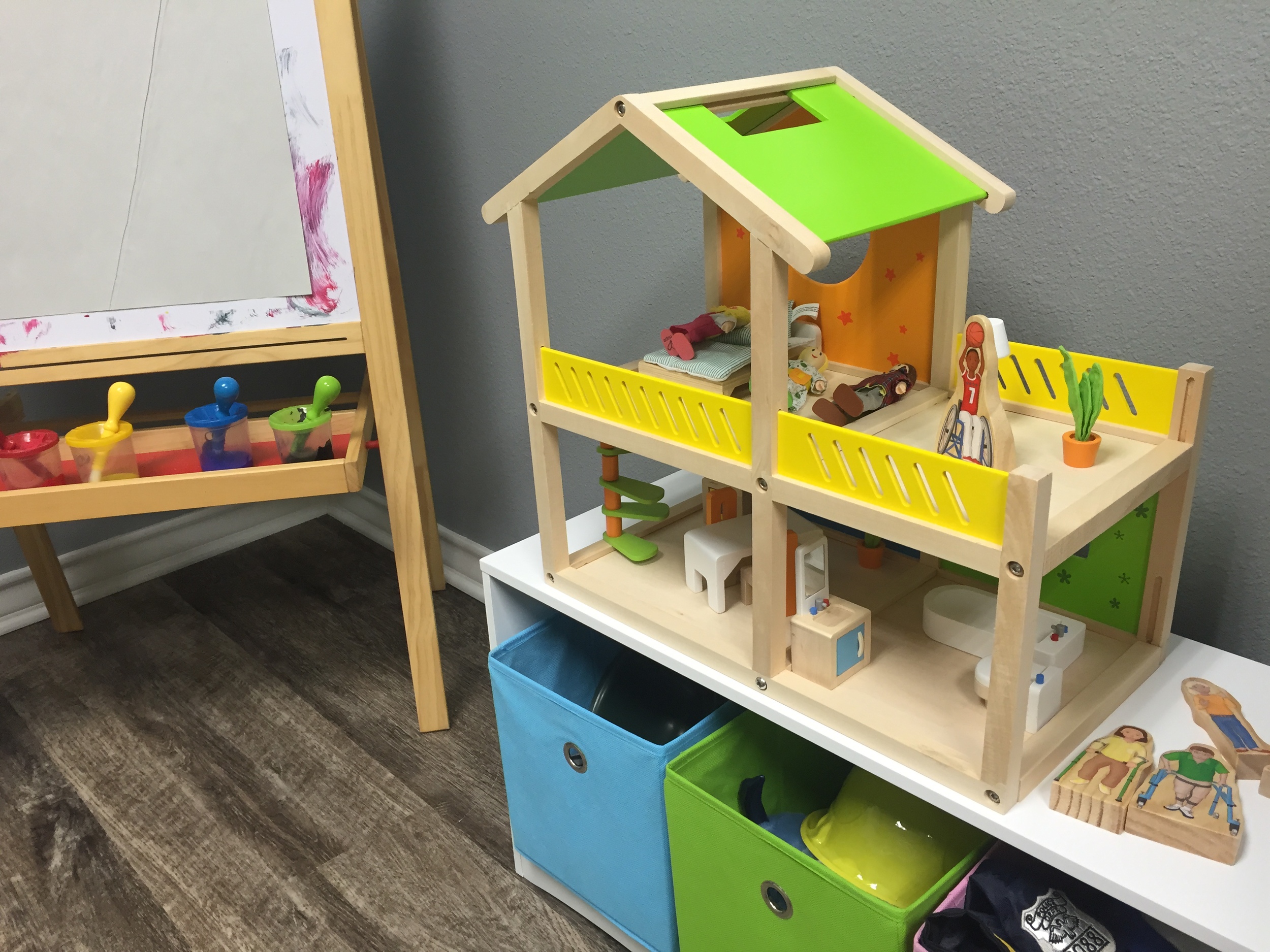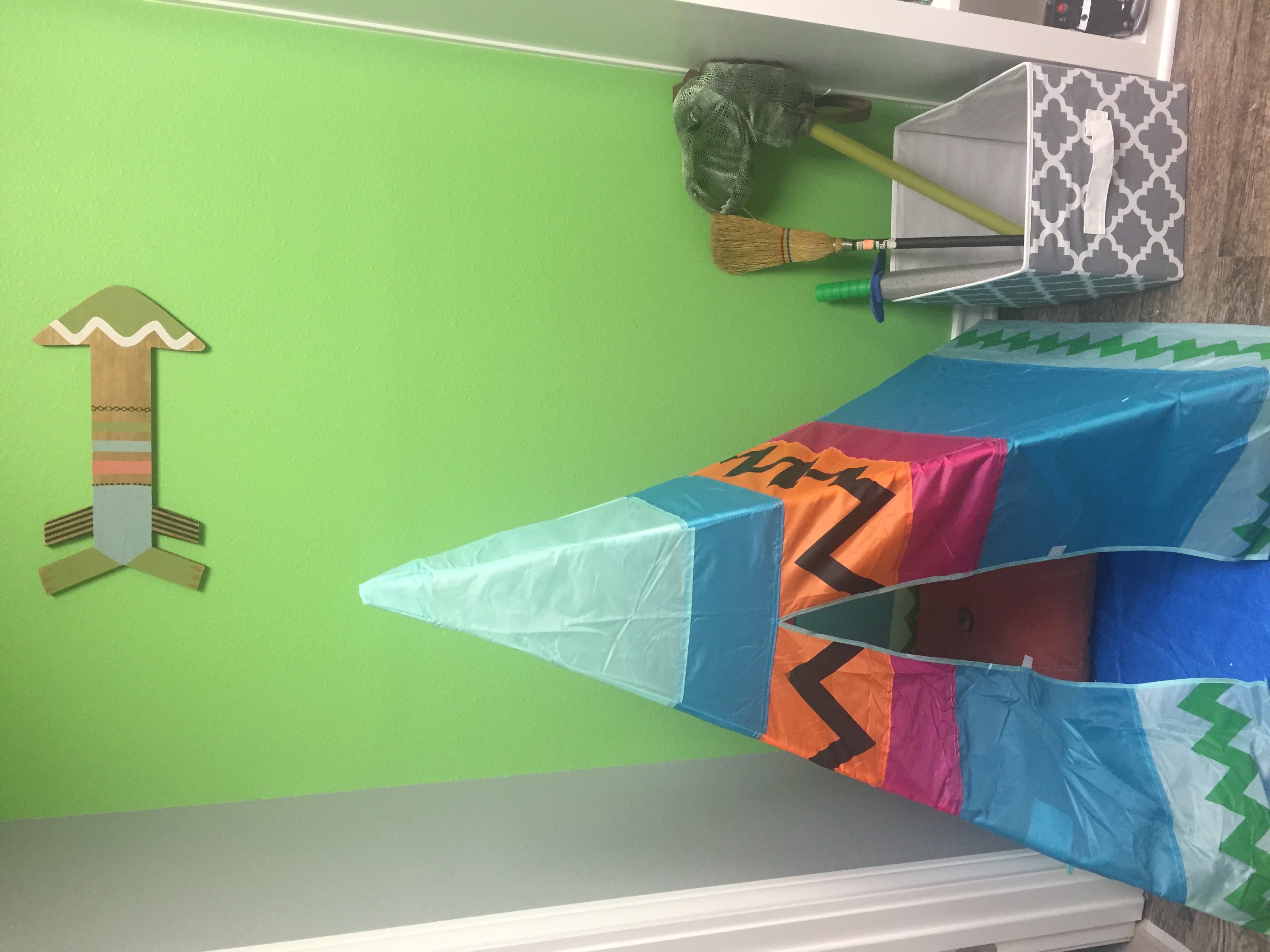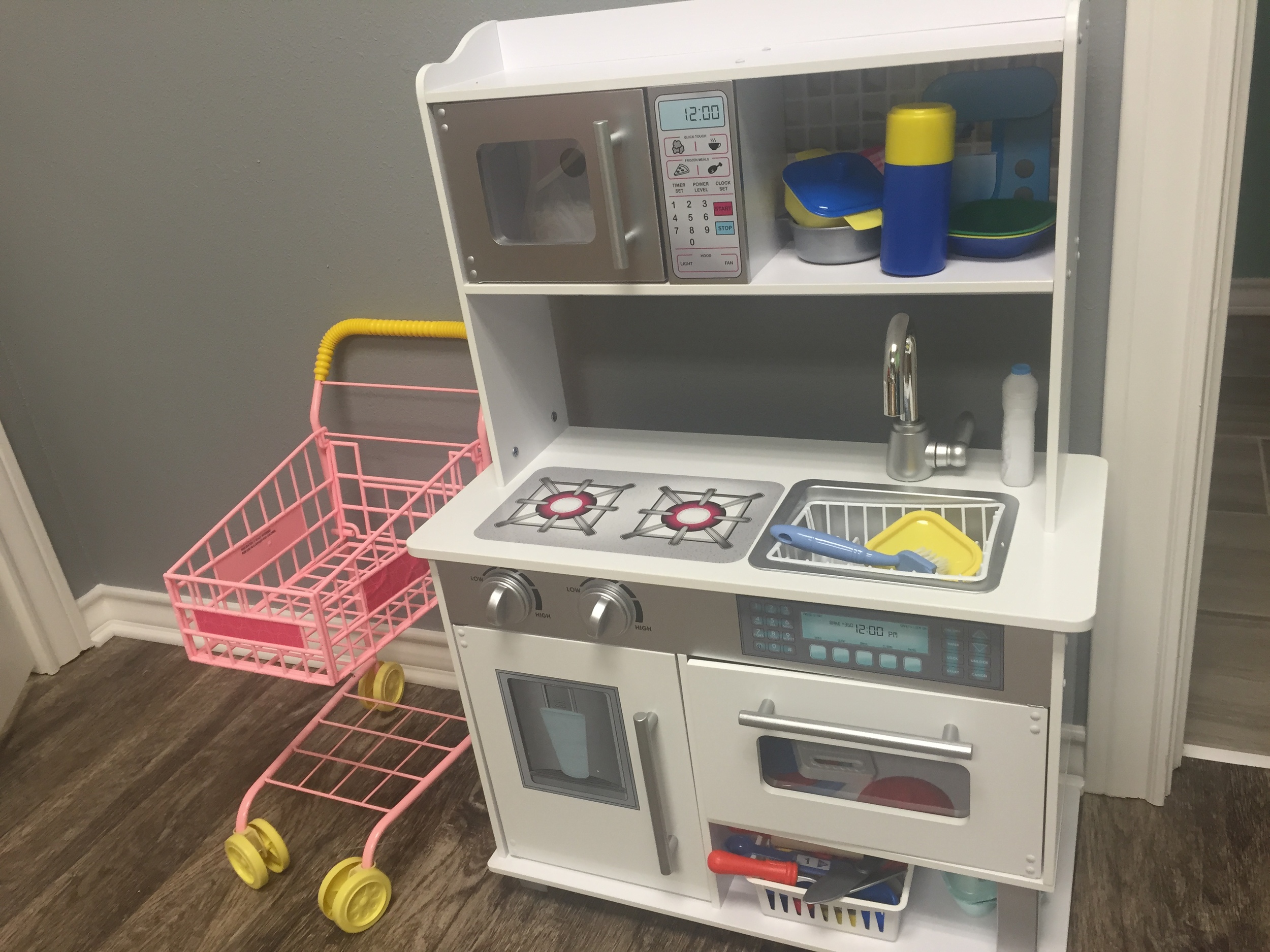Prepare your child about going to therapy by explaining what will happen and why. Knowing what to expect will help alleviate anxiety. Let your child know that they can talk to you about how they feel about their therapist and the process. Discuss with your child’s therapy during the initial intake session about how to introduce your child to the therapy process. Take a look at these age by age guides.
Let's Get on the Same Page About Behavioral Therapy
How Does Play Therapy Help My Child?
As a parent and investor of your time and money in a mental health intervention such as play therapy, you may have some questions around why a counselor playing with your child is helpful. Play therapy is an experiential process which means that a child develops these capacities through the experience: the therapeutic relationship, therapist’s verbal and nonverbal responses, unconditional positive regard, and co-regulation.
There are 4 essential categories of the therapeutic powers of play
Increases Personal Strengths:
Play offers children creative ways to solve problems, enhances moral and psychological development and resiliency, and promotes self-regulation and self-esteem. The therapist builds the child’s capacity for regulation and emotion expression by modeling self-regulation and emotions intelligence skills. These skills then generalize into everyday life. By providing the child with complete acceptance, the therapist builds the child’s view of self and fosters positive self-esteem and self-confidence.
Enhances Social Relationships
Through the therapeutic relationship, play builds social competency, attachment, and empathy.
Facilitates Communication
Play gives voice to self-expression, allows access to unconscious thoughts, and allows for direct and indirect teaching. Play is a medium for self-expression. What children cannot say with words, they show us through play. Often children find it difficult to articulate or express emotions and challenging experiences. Play allows them to do this in their most natural language: play.
Fosters Emotional Wellness
Play gives children space to play out emotions or experiences that they are struggling with.. Both positive and negative emotions are expressed, promoting stress management and overcoming fears. The therapist supports the child to process these experiences in a healthy way.
More specifically , how does it work?
A Child Centered Play Therapist doesn’t suggest that clients play with a certain toy or work on a presenting problem. Instead, play therapists offer warmth, empathy and a gentle structure for clients to make their own meaning through the exploration and play they chose to engage in. Play reveals a child’s internal emotional world. Children have a unique voice in the playroom which doesn’t always include words. Roughly 70 percent of a play therapist’s work is nonverbal and 30 percent is verbal. When play therapy practitioners do speak, it is typically to offer reflection and encouragement on the play they are observing or to offer guidance such as setting limits.
Skilled play therapists can recognize play themes that reflect the child’s emotional needs and use them to help process their concerns. Play therapists respond to play themes, often saying back to the child what she is doing. Children appropriately interpret this as permission to continue, and delve deeper. It also promotes emotion regulation and mindfulness as the therapist attunes to the child, attends to the present, and pairs language with actions, thoughts, and feelings to facilitate integration.
Even though the reason that brought the child to therapy may not be that specific play scenario being played out, a skilled therapist uses a child’s play to address underlying feelings such as helplessness, fear, or anger. As their play moves through specific stages, emotions become less overwhelming, and many families note that behavior outside of the sessions improves.
*Not an actual client pictured with Kelly Martin, child counselor and play therapist.
Lubbock Adolescent Counseling: Play Therapy for Teens and Tweens
Play therapy is an evidence based practice for children and adolescents and has many techniques for counselors to perform. (Bratton & Ray, 2000; Bratton, Ray, Rhine, & Jones, 2005; Gallo-Lopez & Shaefer, 2005; Roaten, 2011).
Working with a teen is very different than working with an adult client due to biological, developmental, and psychosocial tasks. Developmental tasks of teens include: physical maturation, sexual relationships, peer groups, emotional development, formal operations cognitive development, and identity development.
Because of the development of formal operational thought, preteens often vacillate between play that is more common to younger children and activities that appeal more to teenagers.
Play therapy can benefit preteens and teens struggling with depression, abuse, grief, addiction, adoption, ADHD, trauma, family stress, anxiety, relationships, problems with peers, identity, self-esteem, sensory processing issues, body image, anger issues, parent’s divorce, autism, etc.
Rather than teens doing therapy, they EXPERIENCE therapy. It is an opportunity to safely distance the self from problems through activity, creativity and imagination. Using a teen’s interests through play, sandtray figures, and expressive techniques will stimulate the teenager's desire and need to be expressive and create identity--which is central to this developmental stage. The positive therapeutic relationship that develops between a teenager and a counselor brings healing, forward movement, and relief of emotional stress.
Expressive arts are a great tool to address new thoughts and feelings or communicate and rework perspective. It can include art, music, or movement such as yoga or dance.
Games and activities can be used to deal with anxiety, power and control issues, self-esteem, relationships and difficult behaviors.
Sandtray invites adolescents to explore the uncertain world between childhood and adulthood and to explore the internal world and subconscious in a creative way by choosing miniature figures to place in a tray of sand. Sandtray allows clients to become mindful and allows clients the opportunity to blend memories, fantasies, wishes, and emotions without verbal constraints. (Rae, 2013)
““Appropriately structured creative art activities provide preteens with opportunities to change perceptions about self, others, and the world as they try out new roles and solutions...Furthermore, [they] facilitate a process of self-development, providing the preadolescent with the inner resources to cope with future difficulties.”
”
Group therapy is quite effective for making friends, improving communication skills and learning coping skills from peers who experience similar challenges. When the opportunity is available to pair 2 or 3 preteens or teens, group activity therapy can be beneficial.
Trained play therapists can use play therapy with tweens and teens to
Informally assess a client’s psychosocial and psychological functioning
Build rapport
Explore and facilitate expression a client’s inner world and emotions
Build skills through psychoeducation
Develop mastery, identity, and empowerment
Relieve a client of stress
Lubbock Child Counseling: What is Play Therapy and How does it Work?
What is Play Therapy? What is Activity Therapy?
Play Therapy is to kids what counseling or talk therapy is to adults. Children use play as their natural language and the toys are their words. Play therapy allows a child to change the way they think about, feel toward, and resolve their concerns.
For older kids and teens, the counselor will use activities, games, arts, crafts, and sand tray therapy to provide a non threatening means of communication. The activities are selected to help meet treatment goals, although the client is free to carry out the activity or interpret the activity in a way that best fits his/her needs and interests.
Why Play Therapy?
Play Therapy is effective for a wide variety of problems or concerns that affect or will affect the way a child functions at home, at school, or in the community. Child counselors can be and should be specially trained to strategically use play and specific toys to address a child's needs when the child does not have the verbal language to express their thoughts and feelings. The positive relationship between a therapist and child during play therapy can provide an experience that promotes well being and leads to emotional healing.
Play therapy demonstrates significant effectiveness for children and behavioral and emotional challenges. You may read more about play therapy as a successful evidence based practice here.
Who Can Benefit from Play Therapy?
Play Therapy is especially appropriate for kids ages 3-12. For older kids and teens, play provides a safe distance from problems and allows expression of thoughts and feelings. Play techniques for older kids and teens include sand tray therapy, expressive arts (painting, drawing, creating, sculpting, acting, singing), or activity therapy (constructing, building, balls, games, etc.)
What can play therapy do for my child?
Develop responsibility for behaviors
Develop problem solving skills
Learn to communicate with others
Develop respect and acceptance of self and others
Stimulate creative thinking and exploration
Express emotion
Relieve stress
Cultivate empathy
Enhance social skills
Develop assuredness about personal abilities
How long does my child need play therapy?
Each child comes at his/her own pace and with his/her own needs. Therefore, the length of counseling varies. Once the therapist attends an initial parent consultation with the parent/caregiver and it is established that the child will begin play therapy, the child needs sufficient time to develop a trusting and warm therapeutic relationship with the therapist in order to feel safe enough to express to the therapist through toys, sand, or expressive arts, his/her child's world view and perceptions of experiences. The amount of sessions a child attends may range from 4-12+ sessions.
What is the process?
Parent Consultations
During the initial parent consultation (without the child), the parent will have the opportunity to share concerns and background information about the child. The counselor will explain the therapy/counseling process and procedures and will provide a few forms to sign.
Parent consultations (again without the child) will continue every 4th session. These consultations allow the counselor to address the parent's concerns, allow parents to have a better understanding of the child, allow the therapist to share information about the child without breaking confidentiality, and allow both the counselor and parent to communicate progress. It’s a wonderful opportunity to collaborate with parents/caregivers in their efforts to support their child.
Play Therapy Sessions
These sessions are typically 45 minutes in length and may include play therapy, expressive arts, sand tray therapy, or activity therapy in a designated Playroom. The duration of counseling varies from child to child. Individual play therapy sessions include one child and the counselor. Group play therapy sessions include 2-3 children and the counselor.
The Association for Play Therapy outlines the stages of play therapy which helps inform parents of what to expect and guides play therapists during the process. You may read about them here.
What is a Registered Play Therapist?
An RPT is a licensed mental health professional specifically trained in employing the therapeutic power of play. We have extensive training and supervision in play therapy and child development, plus we are already licensed mental health therapists! We receive our RPT credentialing from the Association for Play Therapy (www.a4pt.org).
How does Play Therapy Work?
A Child Centered Play Therapist doesn’t suggest that clients play with a certain toy or work on a presenting problem. Instead, play therapists offer warmth, empathy and a gentle structure for clients to make their own meaning through the exploration and play they chose to engage in. Play reveals a child’s internal emotional world. Children have a unique voice in the playroom which doesn’t always include words. Roughly 70 percent of a play therapist’s work is nonverbal and 30 percent is verbal. When play therapy practitioners do speak, it is typically to offer reflection and encouragement on the play they are observing or to offer guidance such as setting limits.
Skilled play therapists can recognize play themes that reflect the child’s emotional needs and use them to help process their concerns. Play therapists respond to play themes, often saying back to the child what she is doing. Children appropriately interpret this as permission to continue, and delve deeper. It also promotes emotion regulation and mindfulness as the therapist attunes to the child, attends to the present, and pairs language with actions, thoughts, and feelings to facilitate integration.
Even though the reason that brought the child to therapy may not be that specific scenario, a skilled therapist uses this a child’s play to address underlying feelings such as helplessness, fear, or anger. As their play moves through specific stages, emotions become less overwhelming, and many families note that behavior outside of the sessions improves.
For Parents: What is Play Therapy?
All children adjust to challenges; some need extra help to adjust or cope.
Because of the nature of development, children more easily communicate and express how they feel through play, not as much through words.
Play therapy provides toys and materials so that children can communicate what they cannot say in words.
The play therapist creates a safe relationship through and connection through non verbals and through verbal responses. These therapeutic responses are crafted to reflect a child’s feelings, facilitate their decision making and creativity, to encourage, to set limits, and to enlarge the meaning of a child’s metaphors through play.
Children recreate in play the life experiences that are part of their challenges.
Releasing feelings with a safe, caring, understanding adult helps children feel better.
Children’s play evolves until they gain understanding/comfort over their conflicts/worries.
Children learn to express themselves in positive ways, to control their behavior, to make decisions, and to act responsibly.
They change their personal view of life events, enjoy their interactions with others and feel increased self esteem.
Parents meet often with the therapist to express concerns, talk about their child’s behavior at home/school, and receive feedback.
Parents may be asked to join the play sessions and will be given guidance as to how to help the child or respond to the child.
Children need some degree of privacy regarding what occurs in therapy.
There is a possibility that challenges may “get worse before it gets better”; this is not unusual nor does it mean the therapy is not going to be effective.
(*not an actual client pictured with Kelly above)
Play Therapy Poster Gallery
Kelly Martin, child counselor and play therapist of the Playroom Lubbock, along with Deborah Faith Photography created a sense of what a child experiences in a play therapy or activity play therapy session. You are invited to click and browse through our play therapy posters and learn why and how play therapy matters and is effective. (Children used in photos are not actual clients. The playroom is our actual play therapy playroom).
Child Centered Group Play Therapy
Kelly Martin, MEd, LPC, RPT in a mock group play therapy session. Children pictured are not actual clients.
In Child Centered Group Play Therapy, a child learns not only about other children, but also about themselves. Children learn to evaluate themselves in light of peer feedback. CCGPT provides the opportunity for children to build self-concept, self-control, social skills, and awareness of feelings.
“In the process of interacting, children help one another assume responsibility in interpersonal relationships.”
“Limit setting and reality testing occur as the group serves as a tangible microcosm of society.”
Pro Tip:
The dynamics of the interaction increase substantially in group play therapy. Everything is potentially intensified. "Children stimulate each other, challenge each other, and activities requiring limit setting are exacerbated. Unique skills and training are required to be effective in group play therapy" (Play Therapy: Art of the Relationship, Landreth). Individual rather than group child centered play therapy would be most appropriate for children who are extremely aggressive, experiencing difficulty due to attachment issues, or sexually acting-out.
Child Centered Activity Play Therapy Room for Teens/Tweens
Child-centered activity play therapy (CCAPT) can be an effective intervention for pre adolescents, because the child-directed nature of the sessions "provides an opportunity for the child to explore his or her growing sense of self in a safe, accepting environment, free from the pressures and constraints of adult expectations: a situation that is certain to be unique for the unpredictably emotional preadolescent." ( Therapist's Guide to Child Development: The Extraordinarily Normal Years, Edited by Dee C. Ray, 2016). CCAPT allows for the development of self-direction, facilitates the growth of an internal locos of control, and opportunities to gain a sense of competence.
Parent Tip:
Parents, you can allow your child to pick a craft or an activity to do together, and practice using reflective listening while engaging in the activity with the child. Going on special outings can also be beneficial.
“Craft Activities can foster the child’s feelings of competence, while active listening from a parent can help the parent to understand the child better and the child to feel understood.”
Reflective listening can facilitate the child being open with the parent about difficulties at school or with friends. The acronym DEAR is a helpful way to remember the components of reflective listening to your child. Kathleen Scott shares how to connect with your child using reflective listening. (GoodTherapy.Org, September 8, 2015).
Detect: Our role as parents naturally consists of advising and telling our children based on our own judgements. Instead, try observing your child's demeanor, behaviors, tone, and words. By practicing detection, you are likely to discover what is underlying the emotions.
Empathize: Try to empathize with your child's feelings without making it about you. What is their perspective? Connect with your child's feelings. "Wow, Jayden. You seem really angry." "I can see your frustration."
Ask: Ask questions out of compassion. Keep the conversation focused on your child's emotions and story before moving forward to addressing the undesirable behavior or a solution. Paraphrase what you hear. Questions should come from a place of wanting more information. "Can you tell me what happened?"
Reflect: Summarizing what you hear from your child can help dampen the powerful feelings. Your child will have the opportunity to step back and reevaluate their statements and feelings. You are teaching your child to regulate emotions through conversation and process feelings. "What I am hearing is that you're hurt because you were made fun of." "What a terrible end to your school day. It sounds like you've been hurt by people you thought were your friends."
Pro Tip:
No matter the age, there is value in play and creative expression for treating emotional or behavioral challenges. Conventional play therapy may seem juvenile to preadolescents and adolescents so a setting and activities consistent with the developmental needs of preteens is essential. Click here to learn more about Child Centered Activity Play Therapy.
Should my child see a therapist
It can be difficult to know when you and your child can work through obstacles and stressors together and when they might need the help of an expert. Significant life events can contribute to problems with behavior, mood, sleep, appetite, and overall functioning. Other times, what has caused a child to suddenly withdraw, worry, stress, or act out is not as clear. The brain was designed to interact so eloquently with the nervous system and the body. We can listen to behavior, somatic symptoms, and emotional responses as communication. Pay close attention to play, mood, and verbal or written statements for a glimpse into your child's internal world. Here are some indications (not a complete list) that that your child may benefit from therapy:
1. He's having difficulties at home, in school, or beyond.
2. She's suddenly isolation herself from friends or activities. Be on the look out for statements such as "Everyone hates me" or "I'm a loser."
3. They’re regressing. When there are major changes in a child's environment, structure, or schedule, kids tend to regress to a previous developmental stage. Bedwetting, clingy behavior, whining, excessive fearfulness, and tantrums may signal a problem if they develop again and persist for more than a month.
4. She's incredibly sad, worried, or withdrawn. If the worry and sadness is interfering with daily function and routine, it may be out of the scope of normal feelings.
5. His sleep habits and/or appetite has changed. Symptoms such as stomach aches, trouble falling asleep, waking up in the middle of the night, nightmares, excessive headaches, or eating too much or too little may be indication of stress or anxiety.
6. They’ve developed self-destructive behaviors or impulse control is decreasing.
7. He talks about death or thinks about it repeatedly. Children typically develop questions or fears about death around ages 4 and 7. If a discussion about their curiosity or concern does not suffice, and questions and worries persist, talking with a mental health professional may be beneficial.
8. You notice signs of alcohol, drug, or other substance use. They’re engaging in more risky behaviors.
“Your body is a powerful intuitive communicator. Intuition allows you to get the first warning signs when anything is off in your body so that you can address it. If you have a gut feeling about your body-listen to it.”
Just as your child's body and behavior are communicating a need, your parent intuition may kick in prompting you to make a call to a mental health professional. It's also helpful to speak to caregivers and teachers who interact regularly with your child. Discuss your concerns with your child's pediatrician, who can rule out any medical conditions that could be having an effect.
How Do We Start the Play Therapy/Counseling Process? What parents can expect
When parents begin to notice a child's functioning or well being is being affected by a life circumstance or behavior, speaking to a mental health professional is an appropriate first step. At the Playroom Lubbock we do not require a pediatrician referral. You can simply call our office to ask questions, tell us a little bit about your concerns, and book your first appointment. In fact, when you call inquiring about play therapy/teen activity therapy you will speak directly to Kelly Martin, LPC. Once you book your appointment, Kelly will send via email the necessary consent forms and intake paperwork through a secure client portal. Unless you have custody papers or prior assessment evaluation reports, you do not need to bring any other paperwork to the first session.
The first session
The first session is a parent only session with our children's counselor and play therapist, Kelly Martin. There are several topics that will be discussed during this 45 minute session:
- Kelly's practice policies and privacy policies
- Stages of play therapy
- Background history of the child
- Goals the parents have for both the child and for themselves
- A treatment plan for therapy
Warm and inviting office for parent sessions.
The fourth session
Prior to the 4th session, Kelly will send a parent report form for the parent to complete. This gives them the opportunity to record changes, rate progress, and jot down questions or concerns. Every 4th session Kelly and the parents/guardians come back together for a session to discuss progress, changes, review goals, and to provide support to keep the therapy process moving forward. We continue this cycle of 3 child therapy sessions followed by a parent session.
Value of the parent
Parents and guardians are also an agent of change in the therapy process. Parents know their children best and their insight, perspective, and observations are valued and helpful to the counselor in her work with their child.
Preteens Benefit from The Playroom Lubbock Through Activity Play Therapy
Often times people wonder how play therapy is used with preadolescents. No matter the age, there is value in play and creative expression for treating emotional or behavioral challenges. Conventional play therapy may seem juvenile to preadolescents so a setting and activities consistent with the developmental needs of preteens is essential. A a licensed counselor for children, I use expressive arts and other age-appropriate play activities to help older kids/teens work through thoughts and feelings they are either unable or resistant to express verbally. The foundation of play therapy remains the same: play is the language and toys (or objects used in their activity) are the words.
“Appropriately structured creative art activities provide preteens with opportunities to change perceptions about self, others, and the world as they try out new roles and solutions...Furthermore, [they] facilitate a process of self-development, providing the preadolescent with the inner resources to cope with future difficulties.”
I purposefully select games and activities (as outlined in Bratton and Ferebee's article) that promote creative expression, encourage the release of feelings, facilitate the acting out of real-life concerns, and encourage effective problem-solving and coping strategies. The child has the freedom to creatively interpret the assignment.
“There was a child went forth every day,
And the first object he look’d upon,
that object he became,
And that object became part of him
for the day or a certain part of the day,
Or for many years or stretching cycles of years.”
Please take a picture tour of my activity room for older kids/teens. I am continually adding games and objects that aid the therapeutic process. You will notice the inviting and stimulating room for kids to explore, create, and expend energy. Equipment includes an art desk, easel, puppet theater/puppets, sandplay unit and figures, comfortable chairs, dress-up clothes, ball games, art materials, toys for symbolic acting out (dolls, punching bag, knives, swords, etc..), building blocks, toaster oven, and do-it-yourself project kits.
Source: "The Use of Structured Expressive Art Activities in Group Activity Therapy with Preadolescents" by Sue Carlton Bratton and Kelly Webb Ferebee in The Handbook of Group Play Therapy: How to Do it; How it Works; Whom it's Best For by Daniel S. Sweeney and Linda E. Homeyer.
Parents in the Play Room
Often times our children's counselor and play therapist, Kelly Martin, will use parents in the playroom with their child. The purpose of this is to improve connectivity, to enhance the parent child relationship, to increase trust and security, and to increase a level of mutual enjoyment of each other. Through this unique play time with a parent, the child will feel accepted and understood. Through play, the child will have the opportunity to release tension, feelings, and burdens. How a child feels about himself will make a significant difference in behavior.
The main task for the parent during the play session is to see and experience the child's play through the child's eyes. The parent communicates this understanding through an attitude of being present and by verbally describing the play and reflecting the child's feelings.
We want children to experience these attitudes from the parent:
I am here. I see you. I understand. I care.
Listed below are 4 basic skills parents can utilize in a play therapy session:
1. Tracking play: Watch and track your child's activity, expressions, and intentions. Describe out loud what you see so that your child perceives your undivided attention, your child learns words for their actions and feelings, and you learn about your child's play. It may sound something like this: "Oh I see you're filling that up with sand. You laughed when that one spilled out. You are going back to that toy. It seems like you are comparing the two." Notice how the toys were not labeled by the name we know. Allow your child to use and name toys as they perceive them to be.
2. Following Their Lead: Allow your child to decide what and how to play. Do not ask leading questions. Allow your child to be creative. This gives your child a feeling of having control and fosters creativity.
3. Reflecting Feeling: Notice how your child is feeling and verbally tell them what you notice. This helps your child learn words for feelings, it increases their self-awareness, and it shows them you are paying attention. It may sound something like: "You were surprised to find that in there." "You are feeling frustrated getting that open." "You seem to really be having fun."
4. Allowing Mastery of Skills: Don't do for a child what he can do for himself. It's so easy to jump in and assist with a task or to initiate an activity. Wait for your child to ask you to help with a difficult task, but be careful not to completely do the task for them. This sends a message that you are confident in your child's abilities and are supportive of their learning new skills. It helps build self-esteem.
Using parents in the playroom is an important piece to a child's progress. As the parent observes the counselor and learns these special play techniques, the parent can begin using them at home for special play times.
How does the counselor involve parents?
Parents are a vital piece to the child's process in play therapy. Here at the Playroom Lubbock, the parents and and counselor work alongside each other during the course of treatment. I usually tell parents when I first meet with them that when they sign their child up for play therapy, to buckle up and be a part of the ride. Vulnerability and personal growth for the parents is just as important to the child's therapy process as is the child's play "work" in the therapy playroom.
One of my favorite authors and speakers, Bob Goff, provided this anecdote. One of his favorite things about visiting England was the red double decker buses. When he first saw one he was so excited that he took a picture of it. (See picture). He was so close to it he lost sight of what it really was. Sometimes we need to back up our perspective so that we can see the whole picture. This is what the process is like for parents. I walk along side them in this process, backing up to see the whole picture, gaining insight, adjusting perspectives.
To help ease your concerns or perhaps fears of your role in the process, I will outline below how we involve parents.
1. Initial parent consultation session. This is the very first session with the counselor, but without the child. It lasts 45 minutes. We will discuss history, concerns, and what progress you would like to see made with your child. The counselor will also explain the therapy process as well as practice policies and your privacy.
2. Follow up parent consultation session. These typically occur after every 3 child sessions. During the parent consultation meetings you, the parent, will have the opportunity to discuss changes, progress, and concerns. The counselor will cover these 4 topics: Positives, Themes, Goals, and Strategies
Positives: Positive feedback regarding your child's behavior, emotions, or progress of therapy.
Themes: The counselor will loosely discuss play themes that have been observed over the last few sessions. Play themes are dominant or recurring themes within a child's play. The counselor takes in a child's feelings during play, intensity of play, the child's level of including the counselor, a child's level of connectedness, self control, problem solving capabilities, etc. As discussed in the initial Parent Consultation and in your Informed Consent forms, parents are reminded of the value of the therapeutic relationship and the trust that develops between the child and counselor. The counselor will only talk about a child's play to parents in vague terms, not giving many details or specifics. The counselors ask that parents trust that the counselor will communicate to them any "red flags" or concerns that she has regarding the child.
Goals: Based upon parent/school feedback, parents concerns, counselor’s insight, observations, and experiences in the playroom, and the play therapy process, the counselor and parent co create goals and areas that may need additional support in their child’s growth. Goals will be based upon the child’s individual developmental capacities and needs underlying their behaviors. Behaviors are symptoms and clues inside a child’s body, brain, and nervous system.
Strategies: We will discuss strategies for you to use at home to facilitate and support the goals. These strategies may be in the form of suggesting a book to read or may be more direct suggestions of ways of responding or interacting with your child.
3. At times the counselor may send a Parent Feedback form through our client portal. The Parent Report Form gives the parent the opportunity to rate the stress level, rate the overall progress level, state what changes have occurred in the child's life, and voice concerns or questions the parent still has.
4. Sometimes the intervention that is needed to support a child is family therapy or child parent relationship therapy which is a play based approach. These options can be discussed and explained and prepped for during the parent consultation sessions.
We value the parent child relationship and fully acknowledge that the parent is more of an expert regarding his child than the counselor. First and foremost the counselor wants to communicate to both the parent and the child: I am here. I hear you. I understand. I care. Relationship is the vehicle for change. By partnering with parents in considering the whole child and the whole picture, we are hopeful for progress, relief (for both parent and child), and healing that is supported by connection.
A Different Kind of Playroom
Here at the Playroom Lubbock we have 2 Play Therapy rooms for using in child counseling or child play therapy. These playrooms, at first glance, may seem like a kid friendly room with toys, however, the play therapist's selection and placement of toys is deliberate and based upon sound rationale.
“Children are more likely to feel comfortable in places where a sense of openness exists that says to the child, ‘You are free to use what is here. Be yourself. Explore.’”
We have thoughtfully selected the toys of our playrooms so that children will feel a sense of openness and interest rather than caution or hesitancy. The toys and play materials facilitate a wide range of creative, exploratory, and emotional expressions without the expectation of children talking or verbalizing. Mechanical and electronic toys do not allow for children's expressions and therefore are not included in our playrooms.
We want toys to support these essentials of play therapy as cited in Play Therapy: The Art of the Relationship by Garry Landreth.
Establishing a positive relationship between child and counselor
Expressing a wide range of feelings
Exploring real-life experiences
Reality testing of limits and boundaries
Developing a positive self-image
Developing positive self-understanding
Developing self-control
The three main categories of toys in our playrooms include real life toys, aggressive-release toys, and toys for creative expression and emotional release. Below are pictures of our play therapy playroom for children ages 3-10. Soon we will give you a peak into our playroom for older kids and teenagers.
Expressive Arts in Counseling
At the Playroom Lubbock we offer individual and group counseling to kids and teens. You've probably heard us talk about play therapy (using toys as a safe medium for expression) and sandtray (using toys/figures in the sand), but what is "expressive arts" that we talk about? Quite simply, expressive arts is an opportunity to use the arts to safely express oneself and through the process, learn by doing. It uses the arts as a basis for discovery and change. The arts can include art materials, dramatic play, acting, music, dancing, or other artful movements. The emphasis is on the process rather than the product. No previous art background is needed.
When will expressive arts be used at The Playroom Lubbock?
Kids in individual counseling have the opportunity to spontaneously engage in expressive arts because of the assortment of expressive arts materials and toys available to them in the therapy playrooms. The counselor may also incorporate expressive art activities into group counseling or kids groups.
How does the creative process produce change?
Carl Rogers explains that under certain conditions, a person (child) is free to be creative, to be himself, and be open to a new experience of self awareness and change.
“If offered in a safe, empathic, non-judgmental environment, it is a transformative process for constructive change.”
The counselor 1. accepts the child as having unconditional worth 2. listens with empathy and shows understanding of the child through nonverbals and reflective statements 3. provides a non judgmental climate by not making evaluative or critical statements regarding the child or what the child is doing.
The counselor trusts the process that the child (with the help of a safe therapeutic relationship) will take his/her experiences, perceptions, and potential where and when the child needs. *However, there are boundaries and limit setting which can be explained in an entirely other blog post.
A child's expressive art is an image or metaphor representing a child's perspectives, experiences, desires, fears, and goals. Once a child feels emotionally safe and psychologically free, he is able to blossom. It is through the process of creativity that a child gains awareness, resolve, and ideas to move forward. It is not through a counselor's interpretation or analysis of a child's creative product that brings change.
What is the ultimate goal for counseling?
You may have very specific goals for your child. For example, control his temper, obey the rules, not be so impulsive, not be anxious, play better with others, learn social skills, etc...Play therapy, expressive arts, and sandtray therapy will address all of those. However, the ultimate life goals for kids (and adults) is to 1. adjust, change, and seek new experiences 2. be yourself in the present moment 3. trust yourself to make the right choices and take responsibility for your choices and 4. treat others with positive regard, respect, and love.
Let Children Color Their Perception of Therapy
You've made the first step and made an appointment with a child/adolescent counselor. You may have showed up a little apprehensively to the initial intake appointment with the counselor/therapist. After you realize the counselor wants to support your efforts as a parent (you are, after all, the primary influence over your child's life) and the counselor "hears you out," it occurs to you that you have to think of a way to tell your child he/she is going to therapy. In fact, let's just cut out the word "therapy." Add "fix your problems," "bad feelings," "disobeying" to the list of What Not to Say. "Ideally, it is best if the child is allowed to develop their own impressions of the therapist and what therapy is all about from actual experiences in the playroom" (Killough McGuire, D. and McGuire, D, 2001. Linking Parents to Play Therapy. NC: Taylor and Francis). We hope our name, The Playroom, provides a sense of comfort and familiarity for your child so that he feels safe and free to form his own impressions.
So How do You say It?
McGuire and McGuire in their book Linking Parents to Play Therapy suggest parents tell their child (depending on developmental level) something like this: "This is a time for you to play in a room full of toys and things you like to do with someone who really cares about you" (p. 16). As necessary, the therapist can also provide further information to the child. Another way to phrase this for an older child would be:
“It’s a safe place to find support and an unbiased adult to listen. ”
Communicate with Feeling Words
When your child comes out of a session reflect his/her emotion. "You're really excited coming out of there." "You seem to feel quiet." "You're feeling ready to go!" You can also respond with a feeling to any questions they may have: "You're curious that_____." "You're wondering if ______."
Communicating about their Art/Creations
At times your child may bring home something he/she created. It is important to view their creation from their therapy session as a page out of a journal. It can be very private and emotional. Be mindful that your child may choose not to talk about it. If your child is eager to show you (and quite honestly you may have no idea what you are looking at), you can say "Tell me more about that." You can focus on details of what he or she did: "You put those colors right there." "Looks like you spent a lot of time on that." "You drew this here and that over there." Or if a child asks you if you like it, you can respond with, "What's important is if you like it. What do you think about it?"
Communicate with Nonverbals
Dr. Kay Sudekum Trotter, PhD, LPC-S, suggests that when you stay in the waiting room instead of running errands during a session, you nonverbally communicate that "you're so important to me that I will be here the whole time supporting you." (Tartakovsky, M. (2015) Common Things Parents Say to Their Kids about Therapy that Aren't Helpful. Retrieved from PsychCentral.com)
Communicate Privately with the Therapist
It is important to be mindful of little listening ears. Talking about your child's progress or lack there of, or more specifically the problems you want to see addressed, in front of the child, may lead to feelings of inadequacy, embarrassment, and shame.
What NOT to Communicate:
The following list of common comments that parents make may isolate your child or negatively color their perception of therapy or the therapist.
“The therapist is going to help you with your problems. You need help”
”We can’t help you anymore because your problems are too big.”
”We have to go to therapy because your dad or mom left us.”
”You need to go to therapy because since the divorce you have been really emotional and difficult to deal with.”
”Your therapist is going to be so disappointed in you for doing___”
Speaking to therapist: “Maybe you can help _____with learning how to better control his emotions when he doesn’t get his way.”
In Conclusion
Parents are very well meaning in their communication with kids. Hopefully these suggestions provide another perspective about how your words can and should encourage your child and therapeutic play.
Collaboration with Parents in Play Therapy
At The Playroom Lubbock we provide optimal and collaborative therapy solutions. Collaboration begins and continues with parents/caregivers. Parents or primary caregivers know their child best.
How does collaboration with parents/caregivers work in Play Therapy or Child Counseling?
Before play therapy sessions with a child begin, the counselor will set up an initial parent consultation appointment (without the child present). During this consultation the parent will have the opportunity to share concerns and background information about the child. The counselor will explain the therapy process/procedures and will provide a few forms to sign.
Parent consultations (again, without the child) will continue after each 3rd session with the child. These consultations allow the counselor to address the parent's concerns, allow parents to have a better understanding of the child, allow the therapist to share information regarding the child without breaking confidentiality, and allow both the counselor and parent to communicate progress.
At The Playroom Lubbock, we seek to also strengthen the parent/caregiver role. We believe parents and caregivers are a vital resource to understanding a child and for a child's progress.
